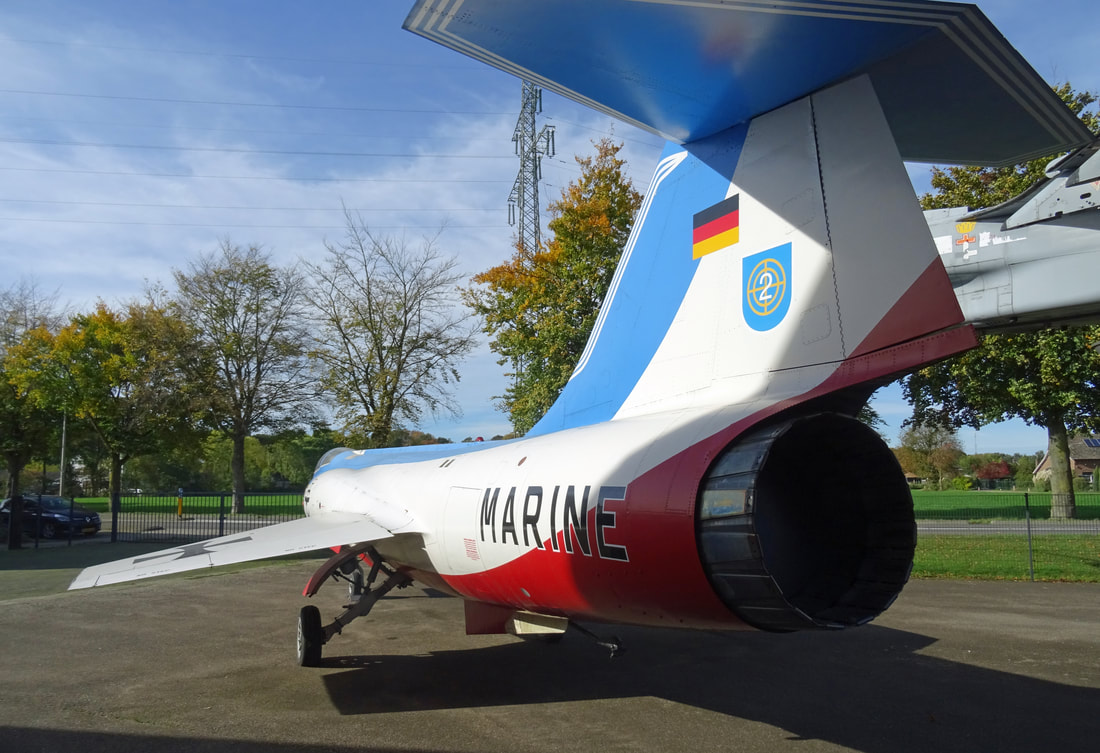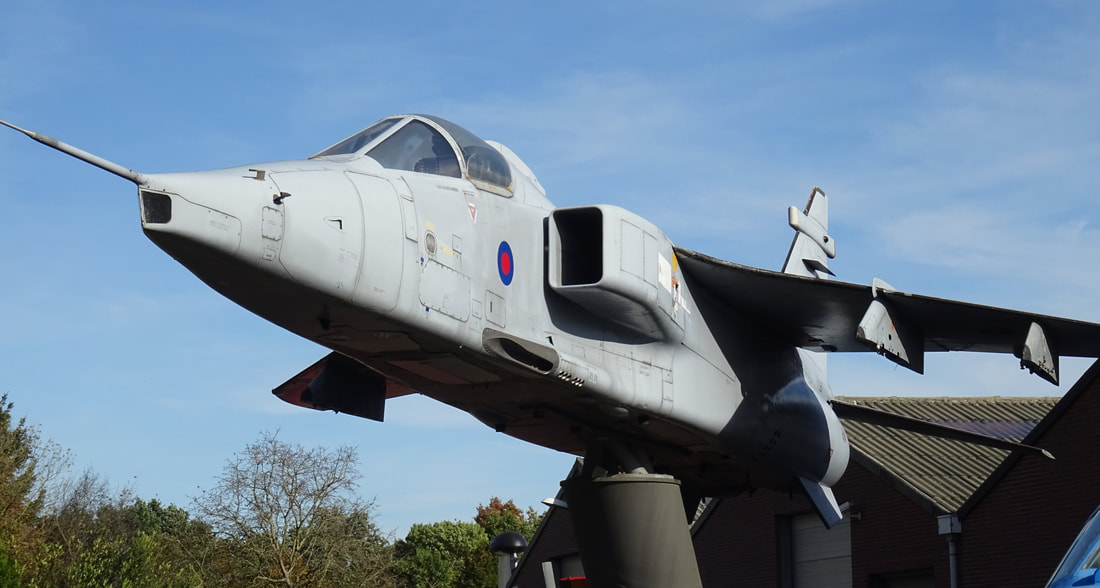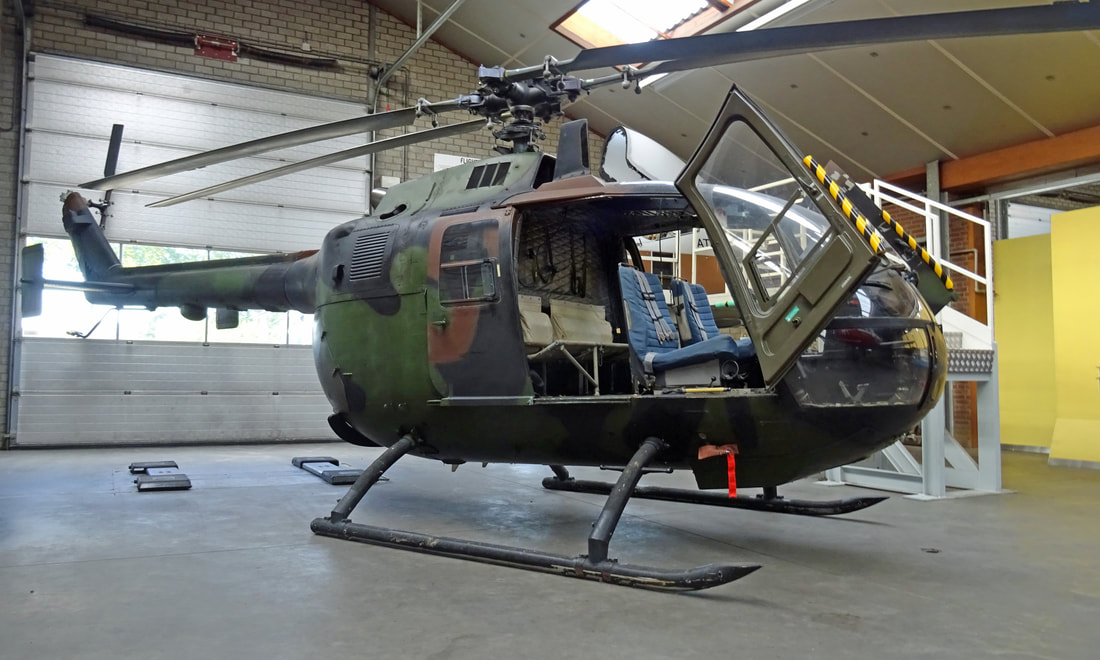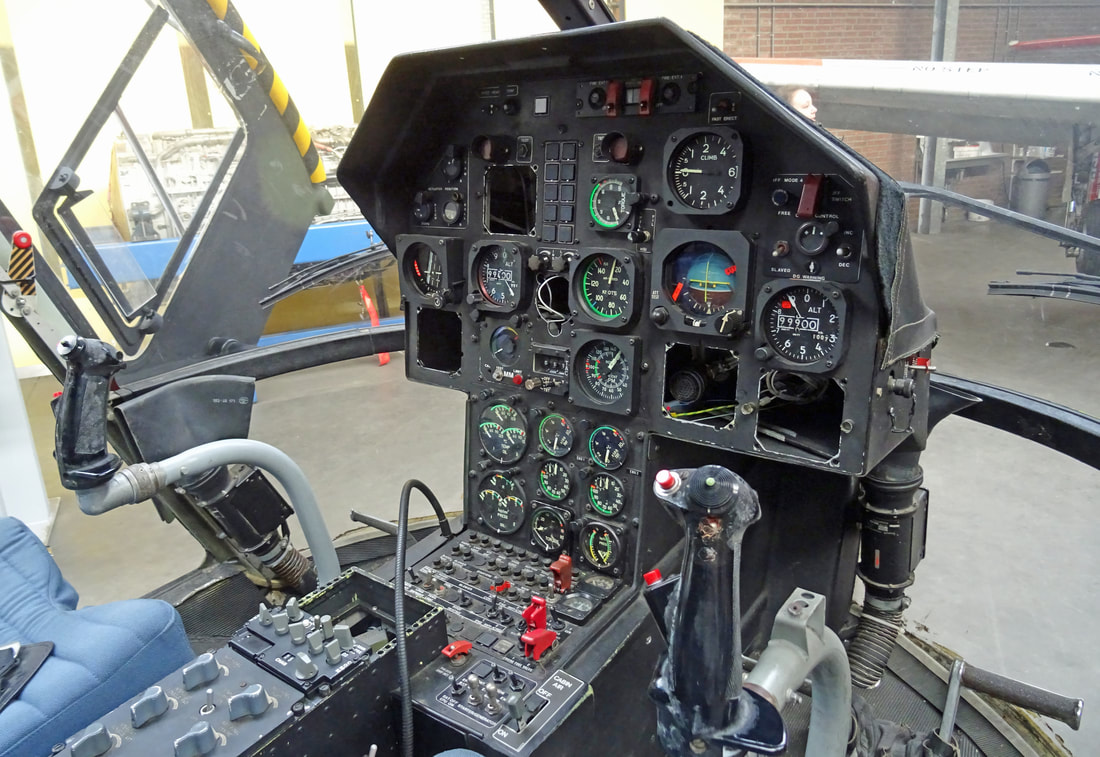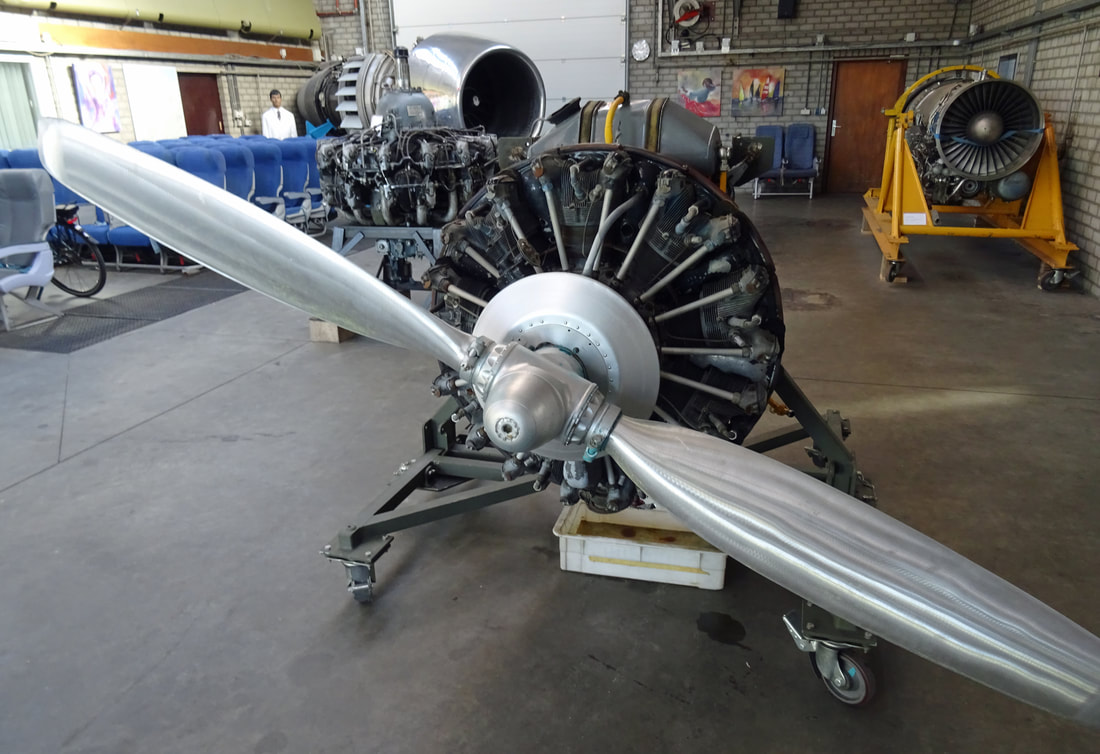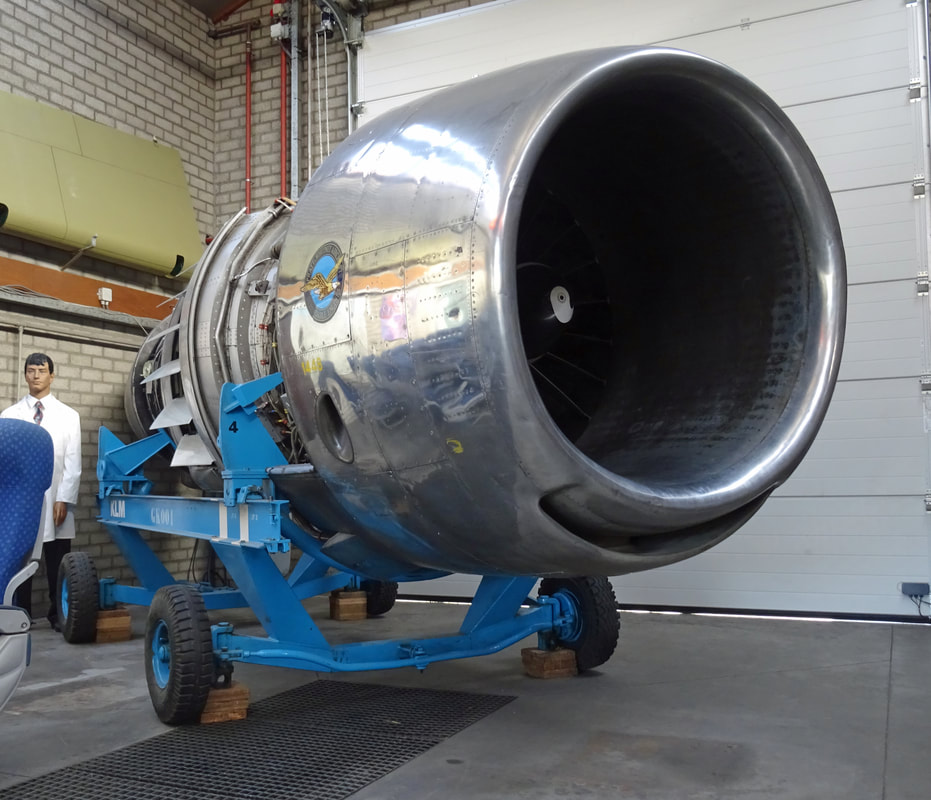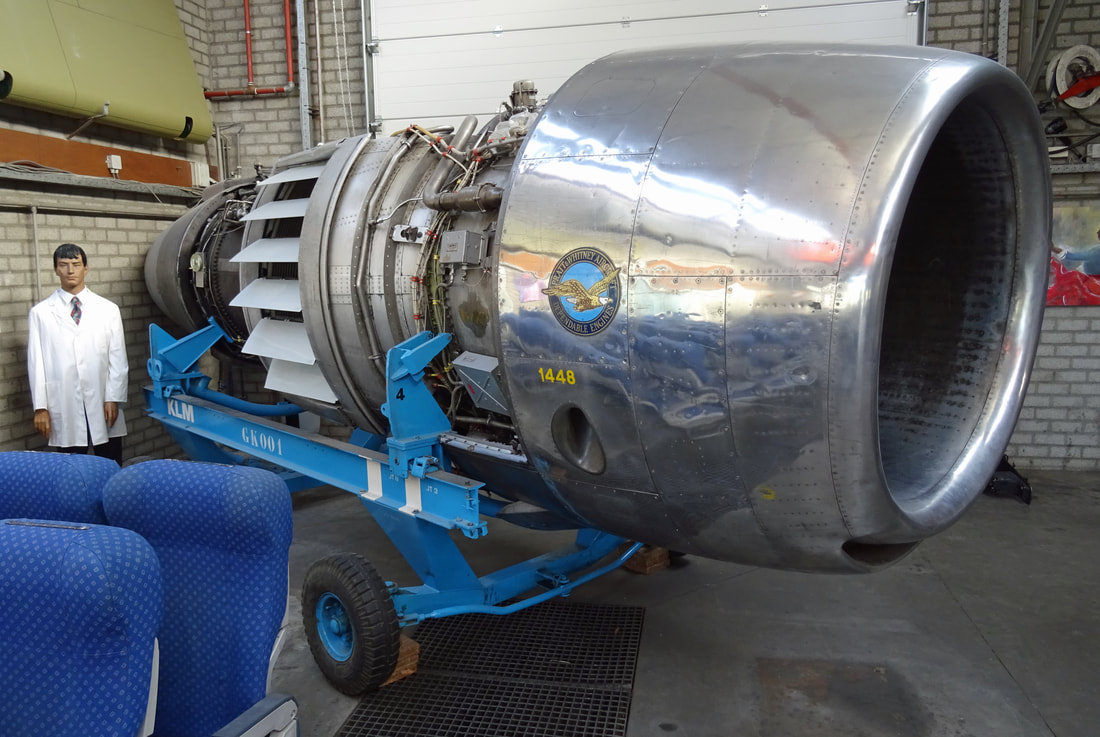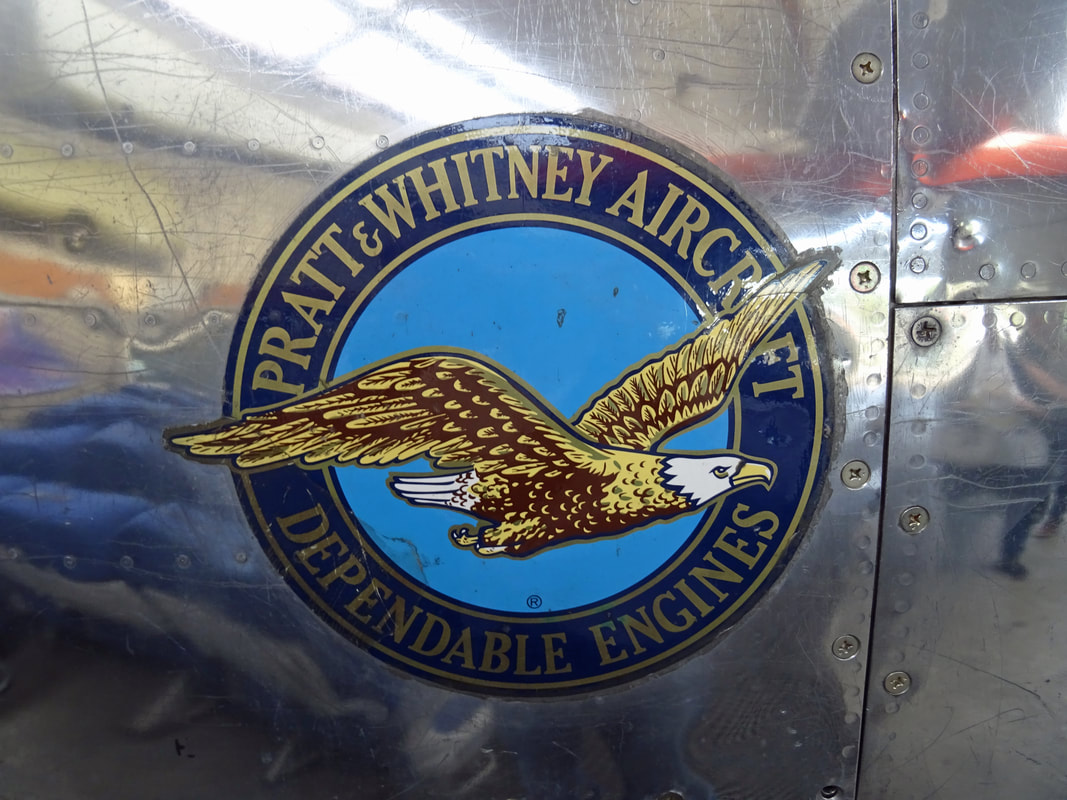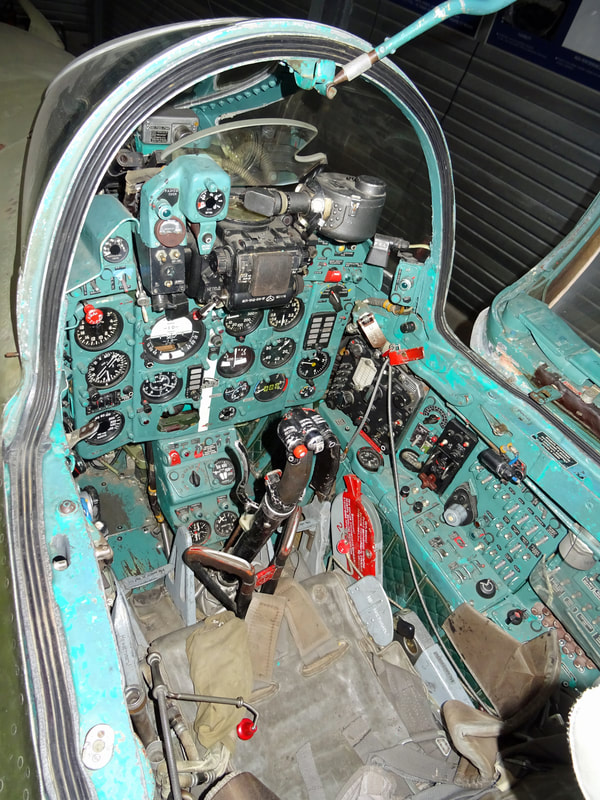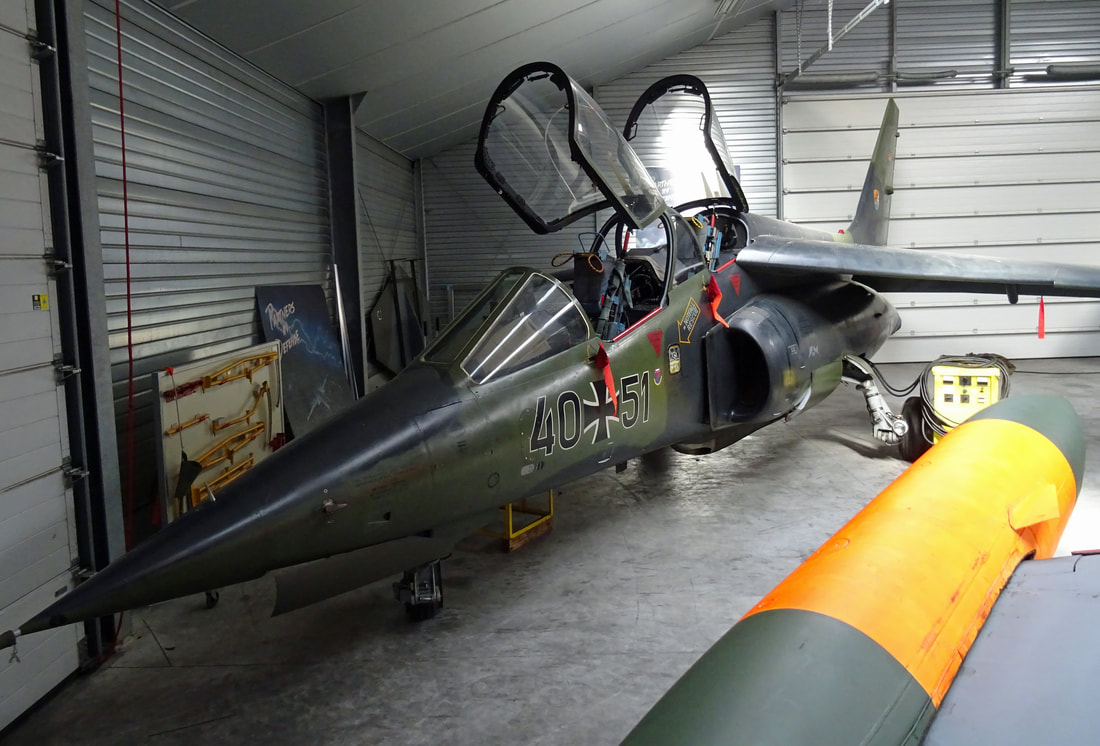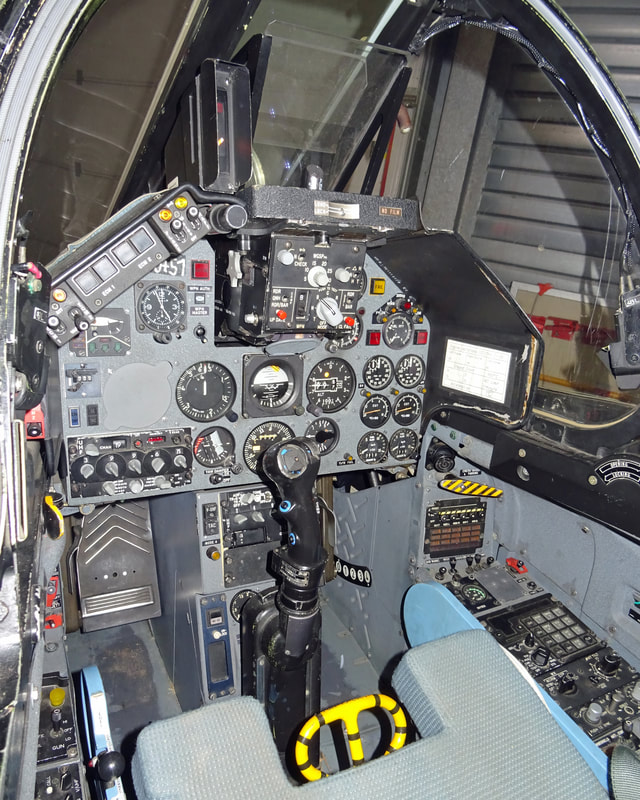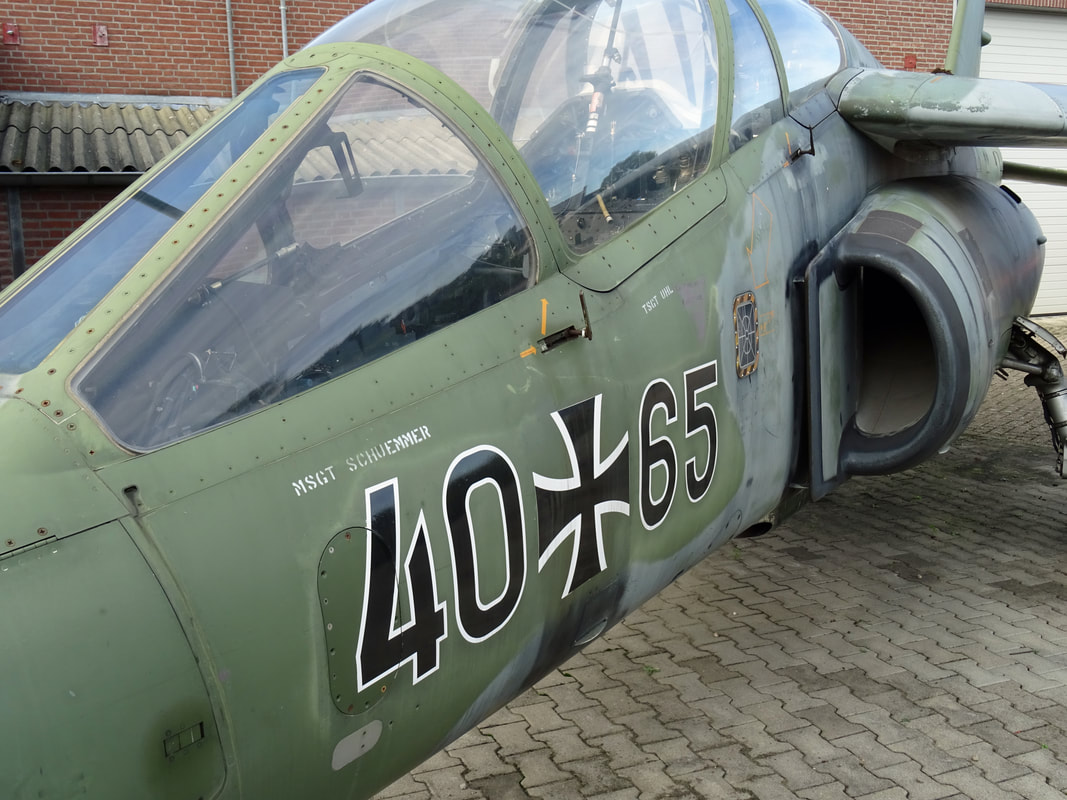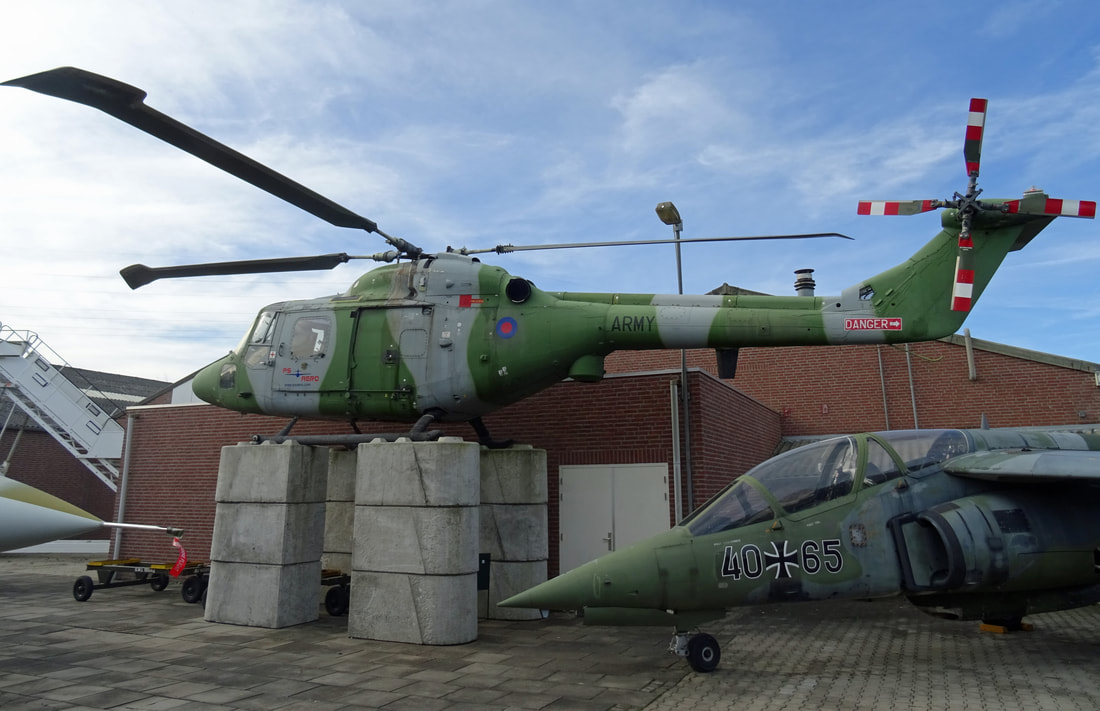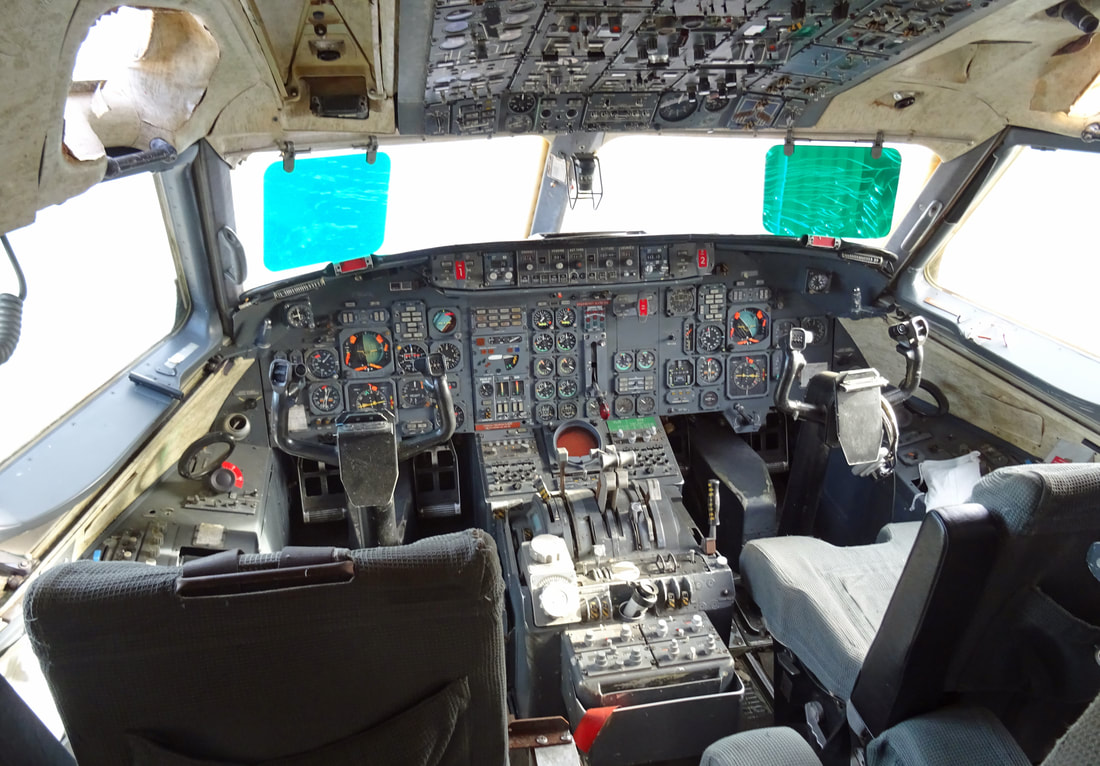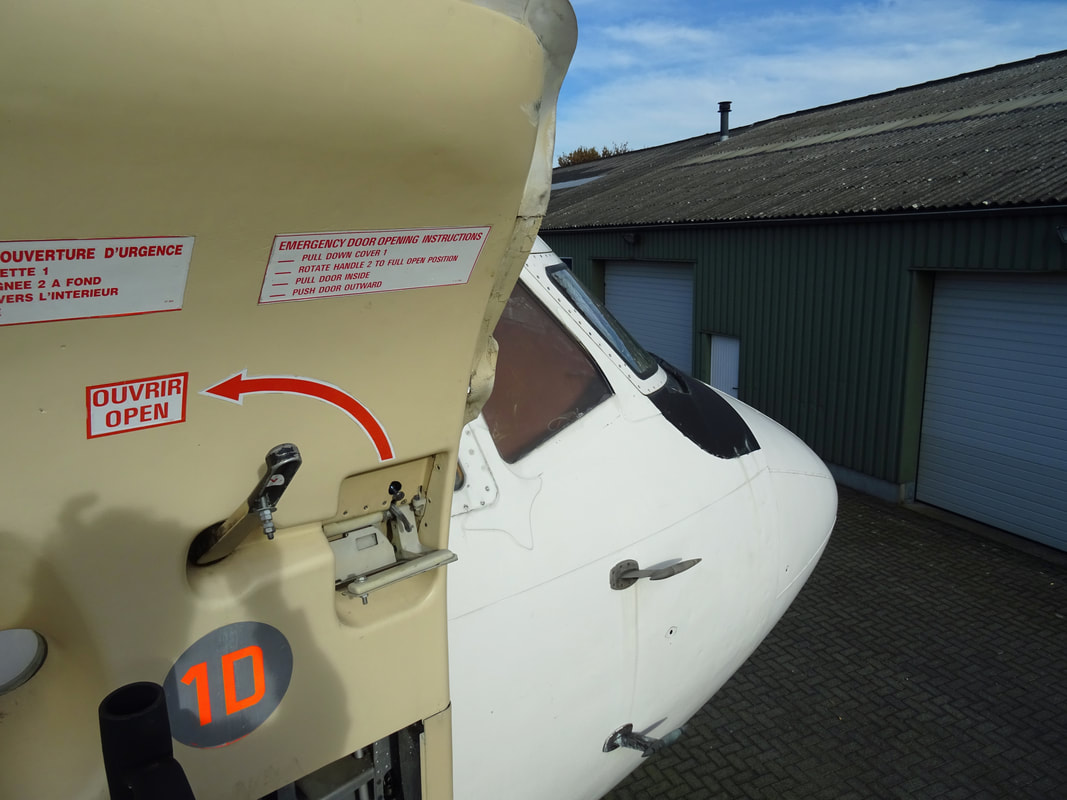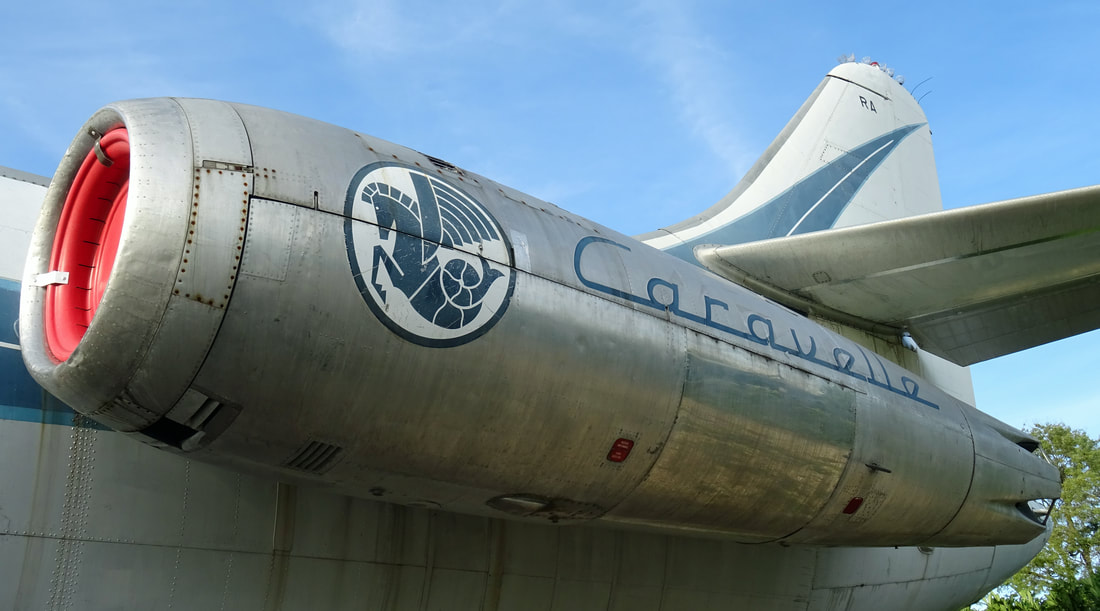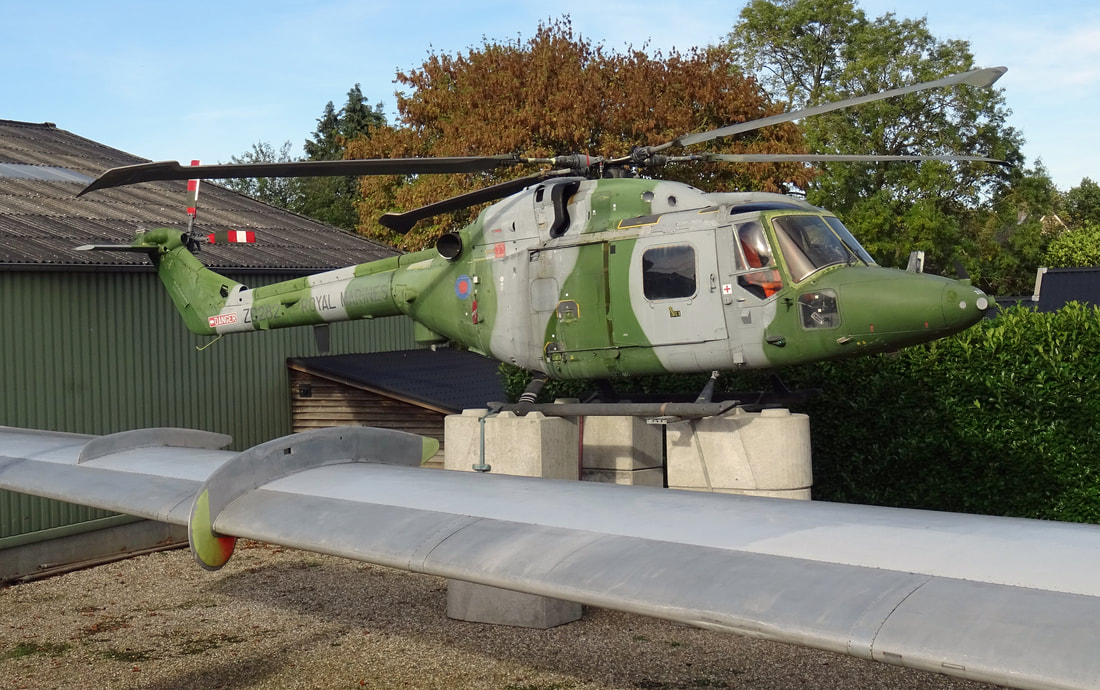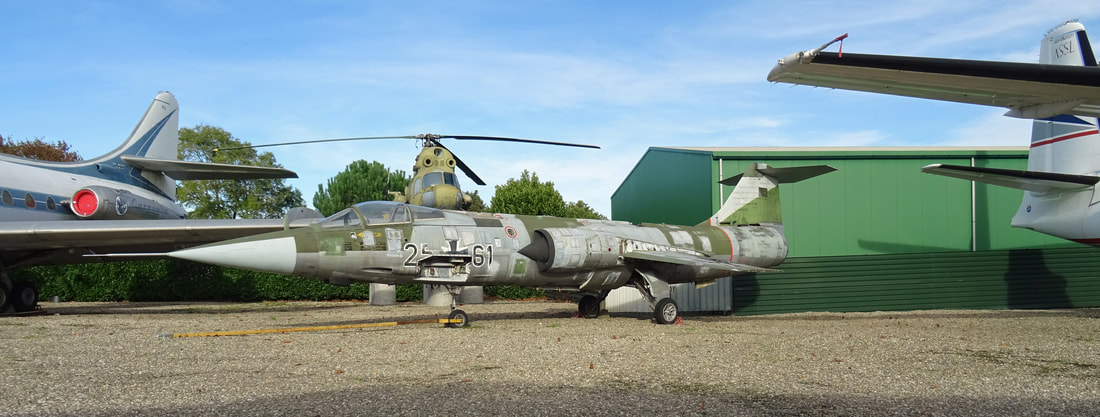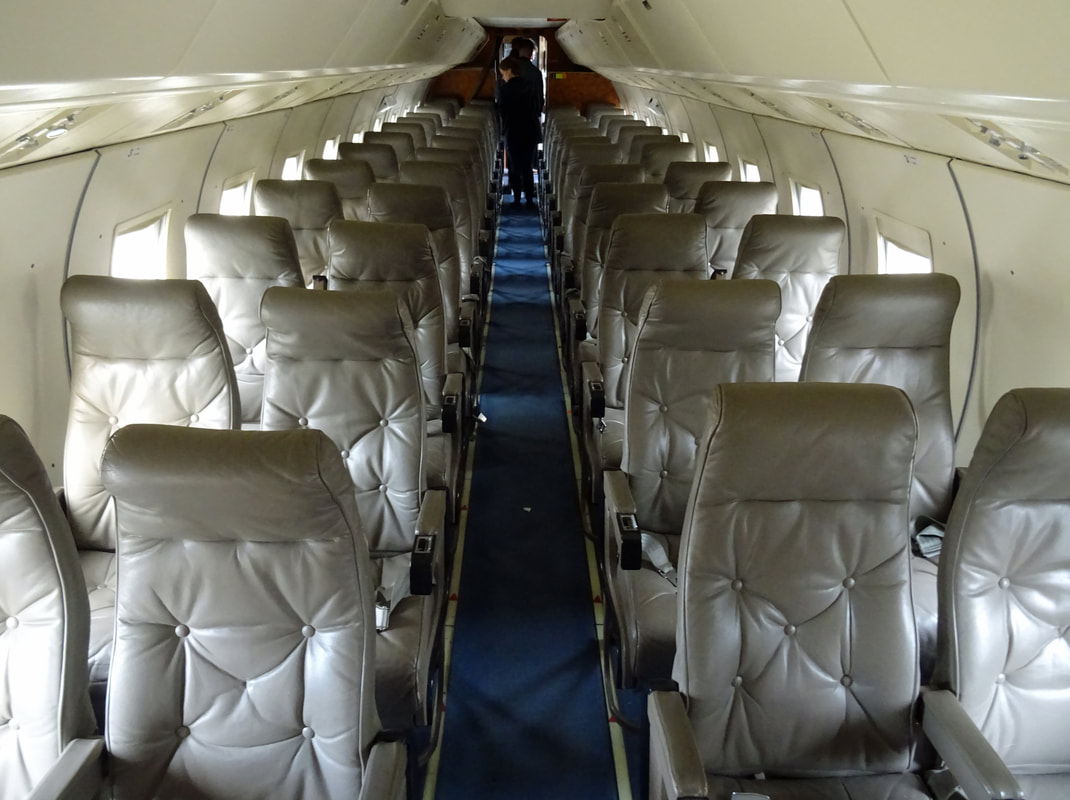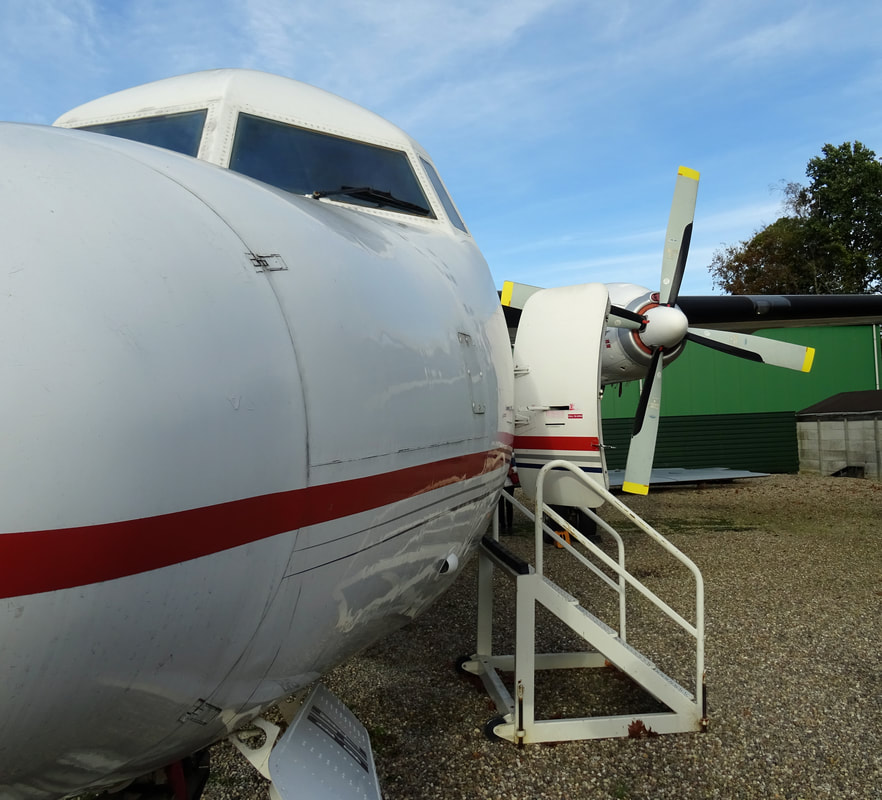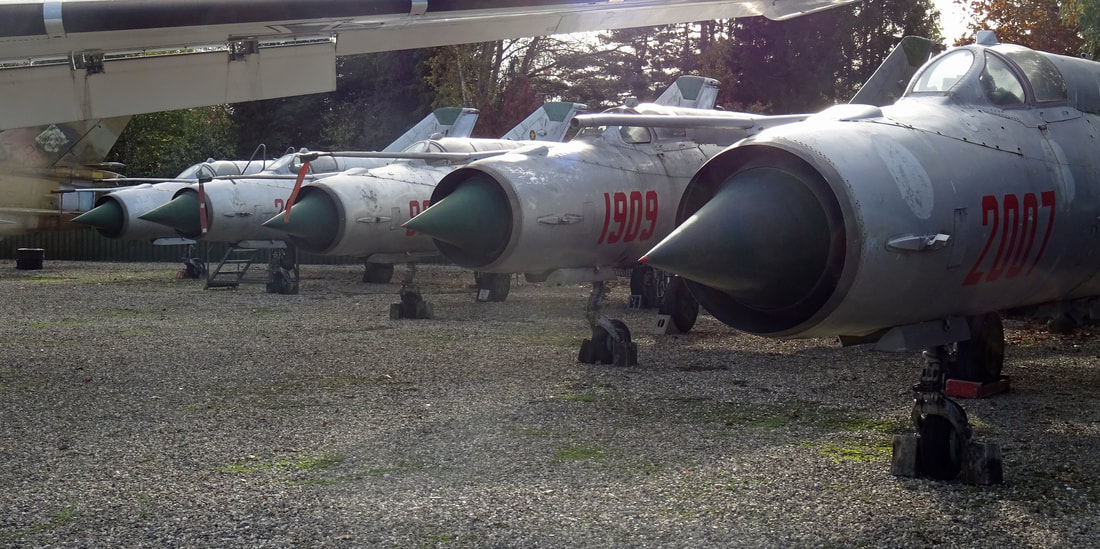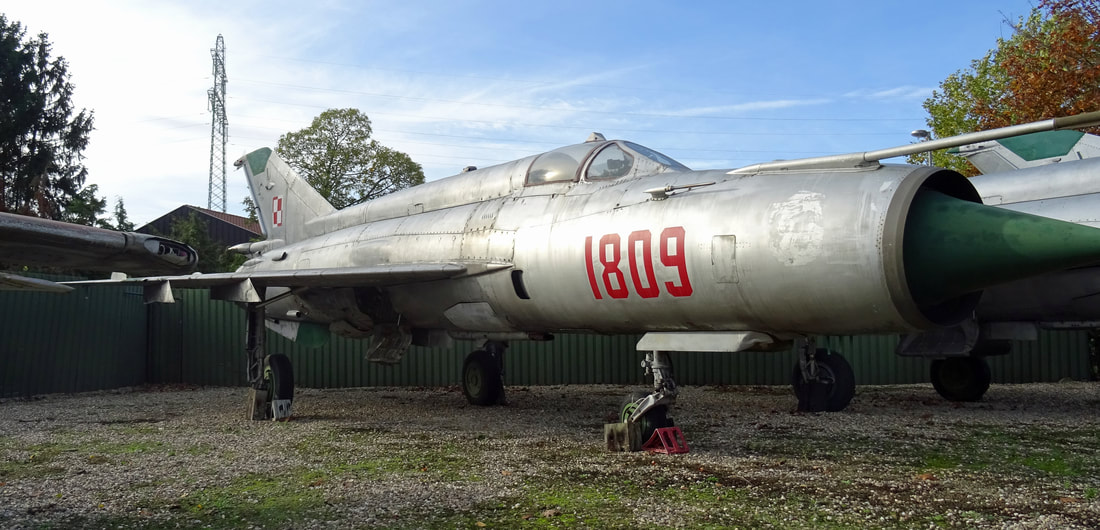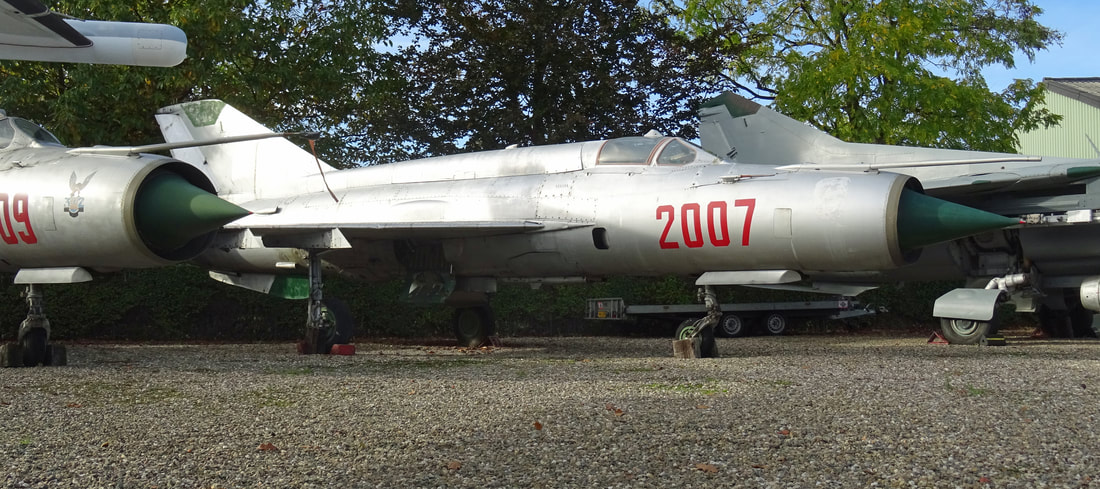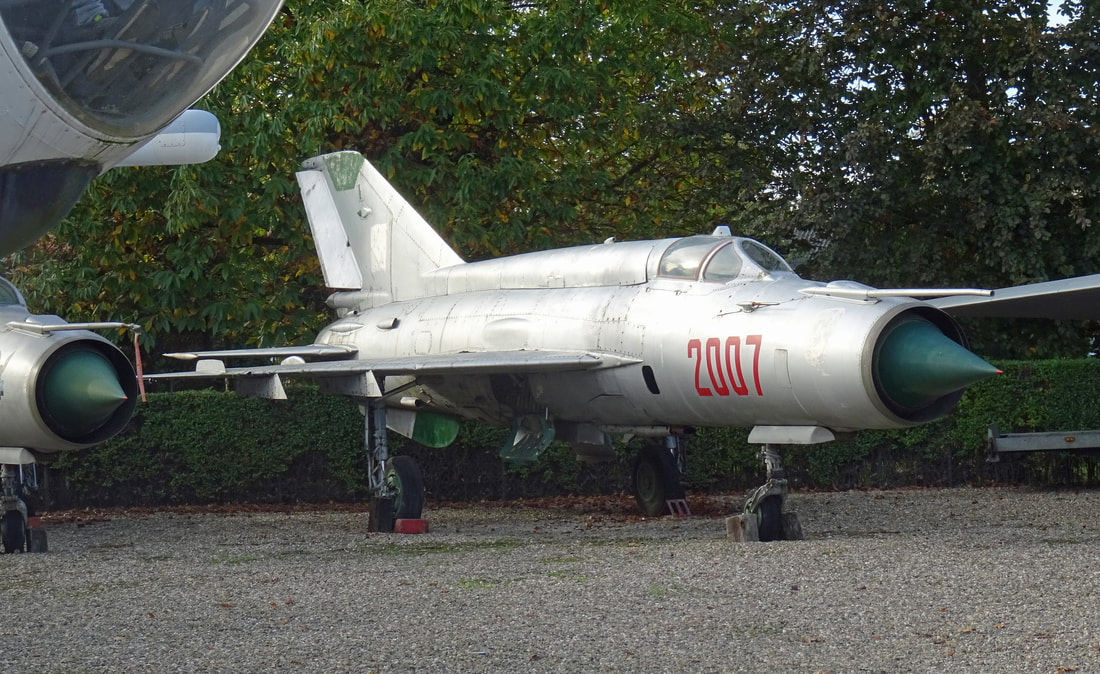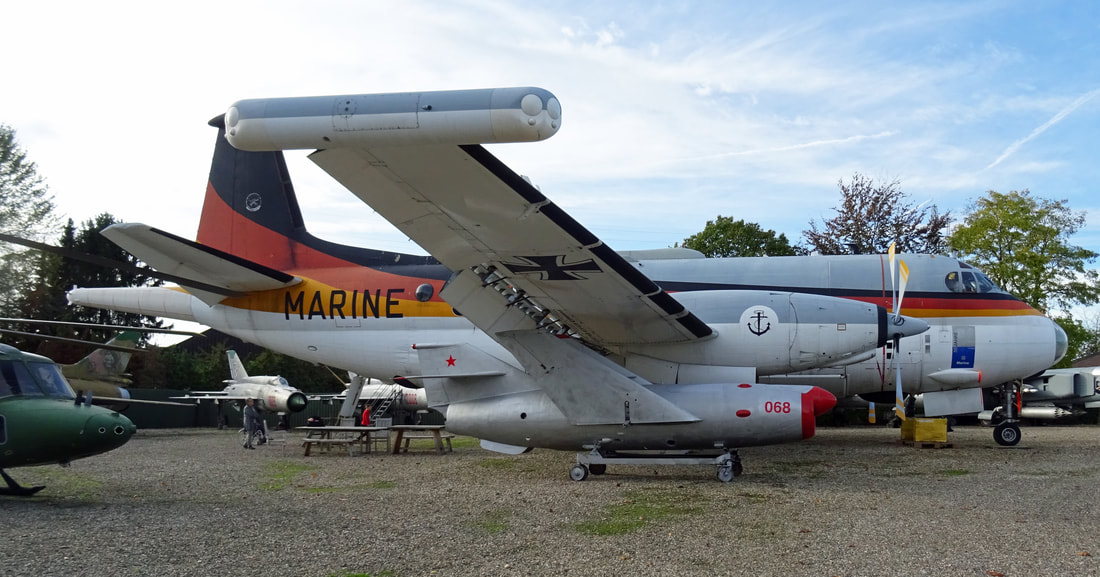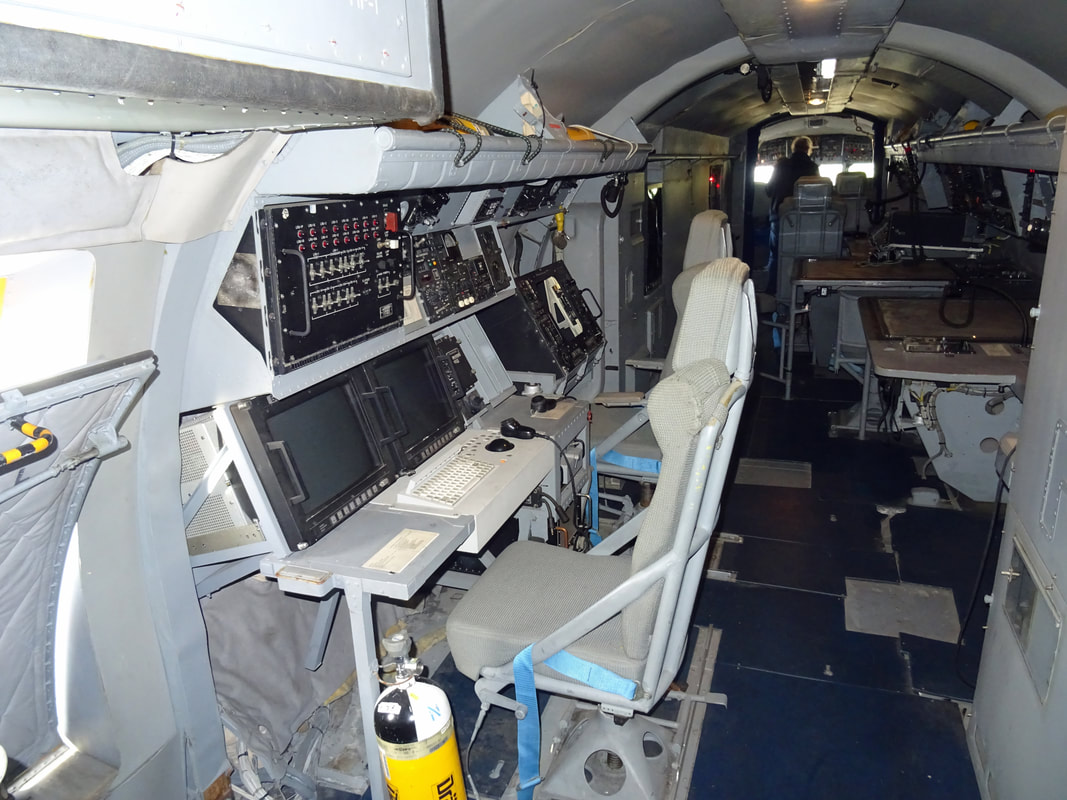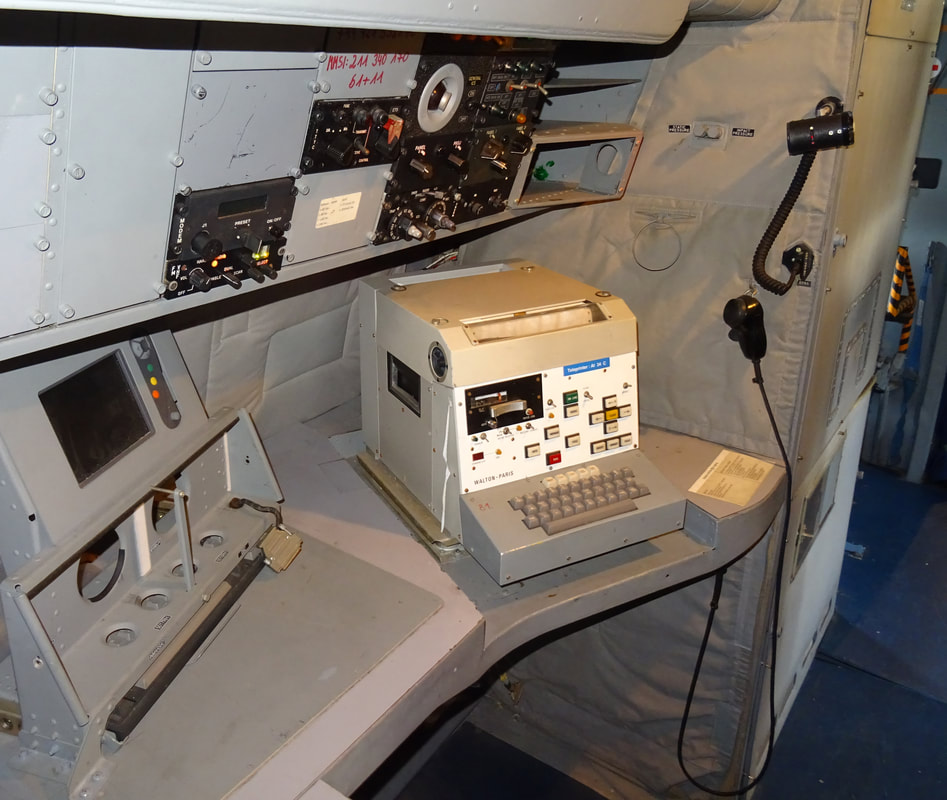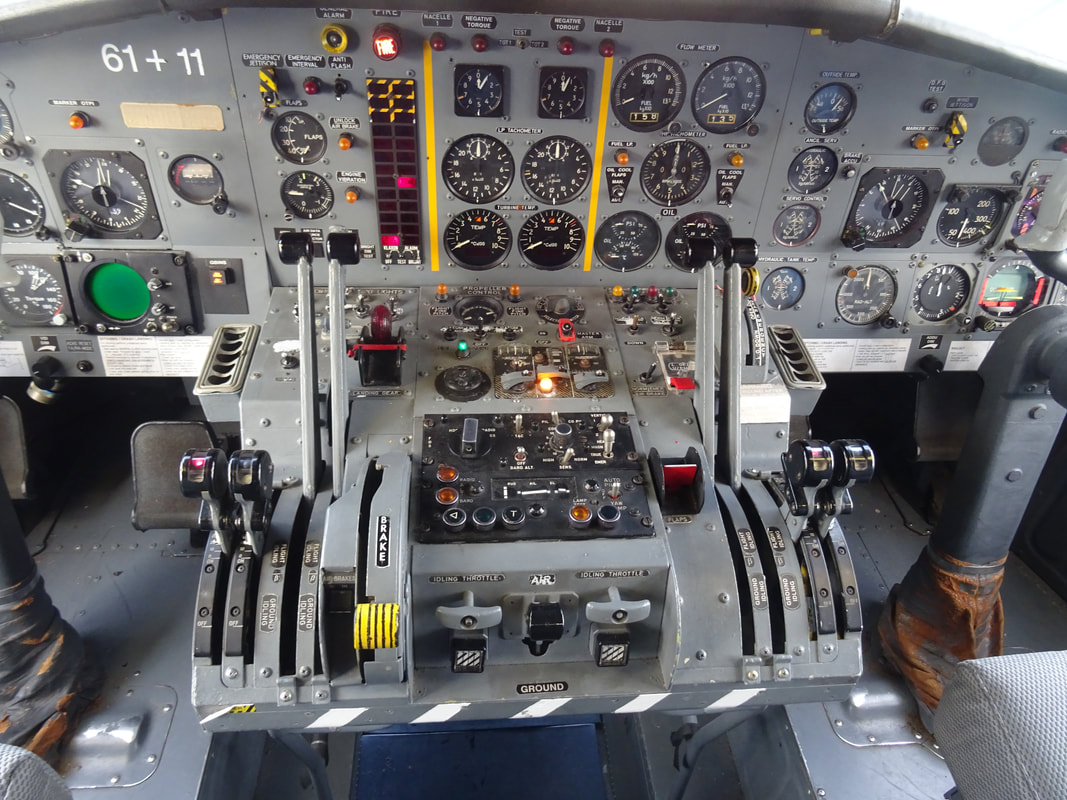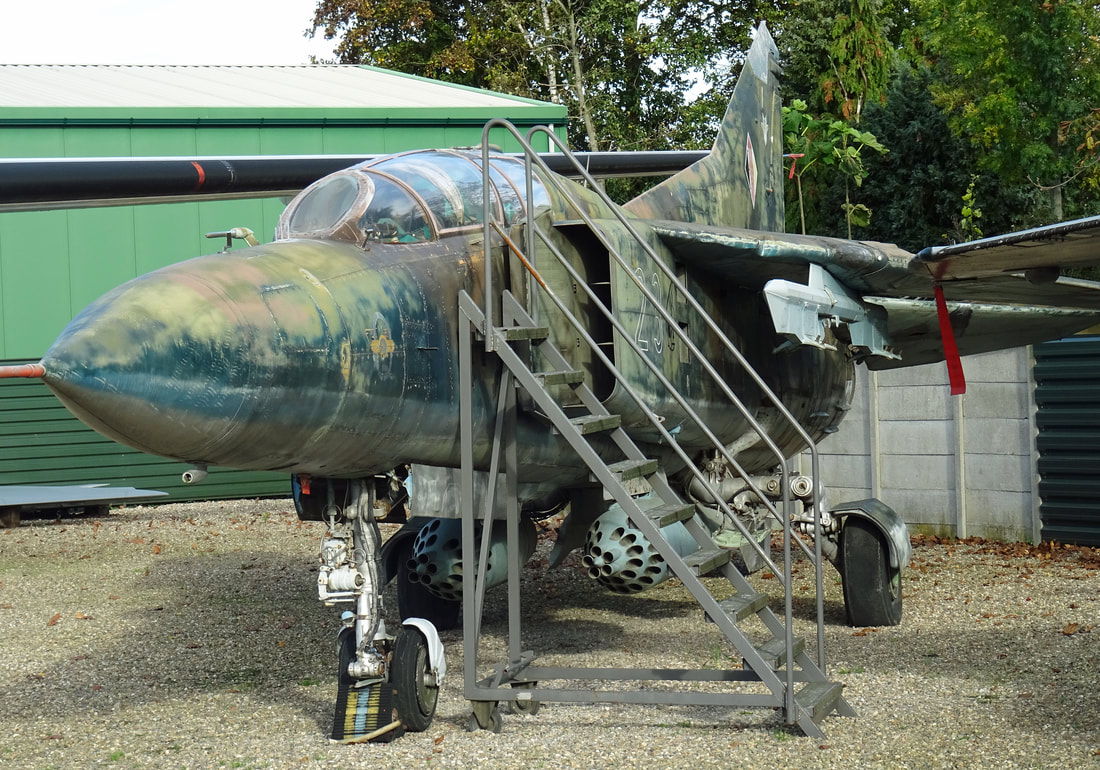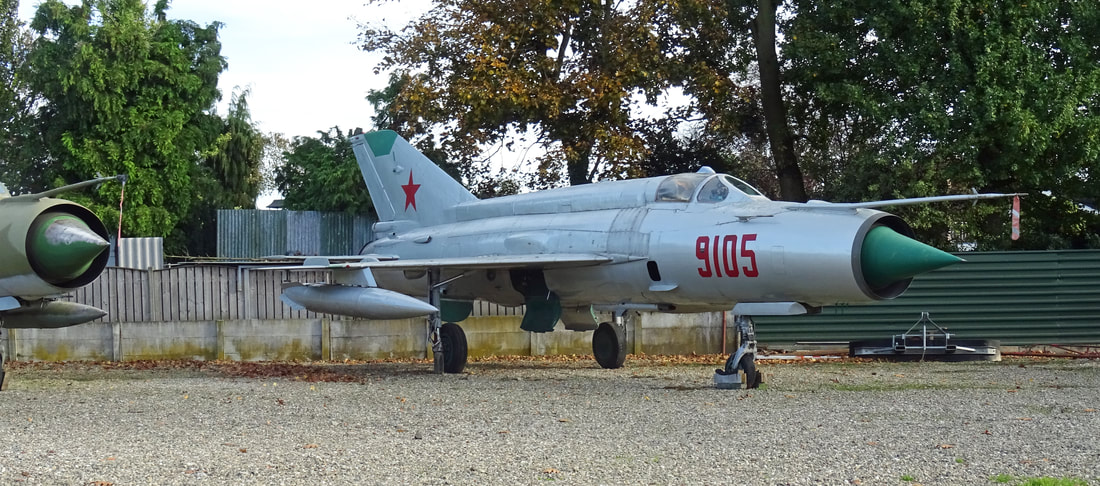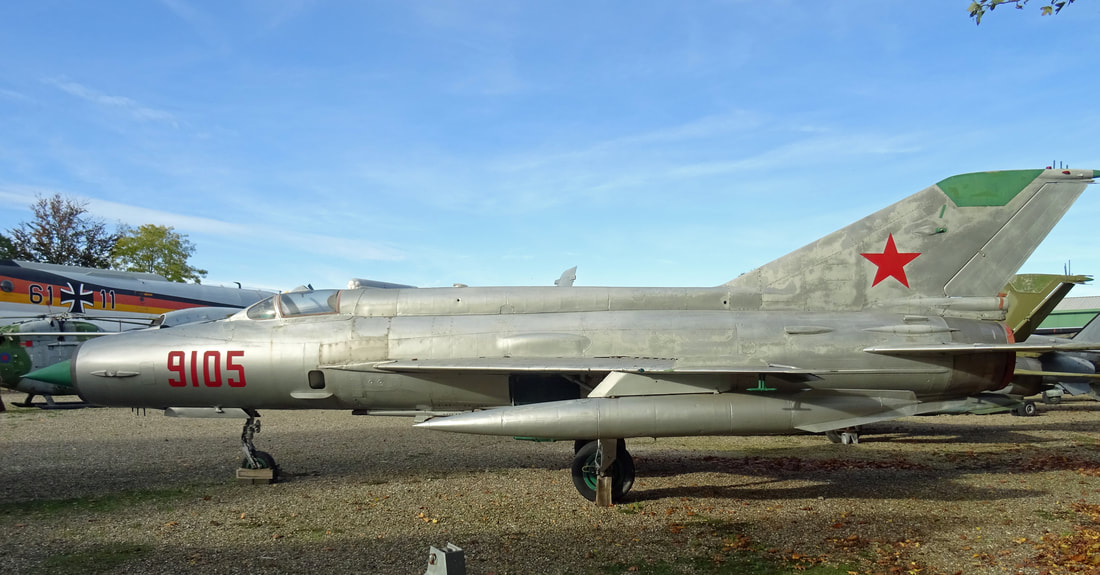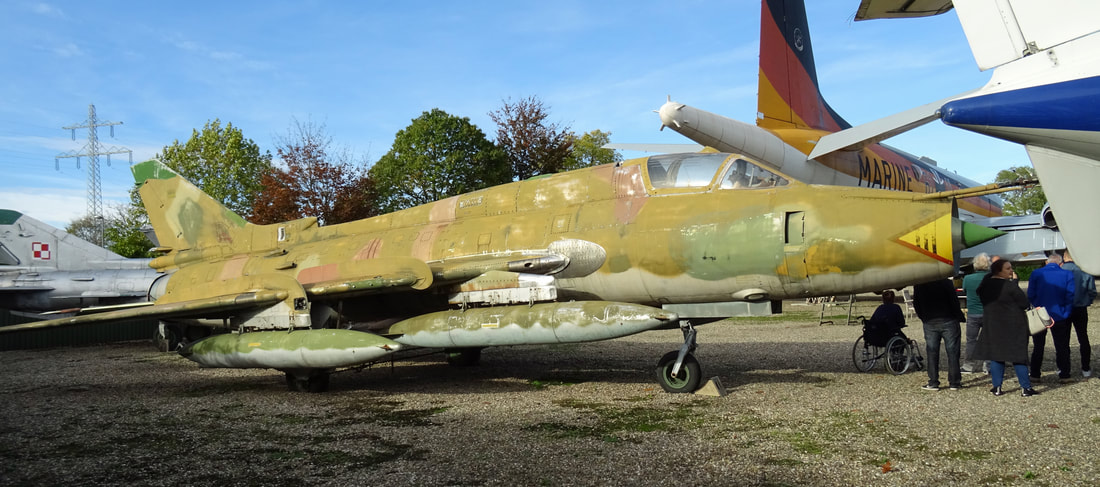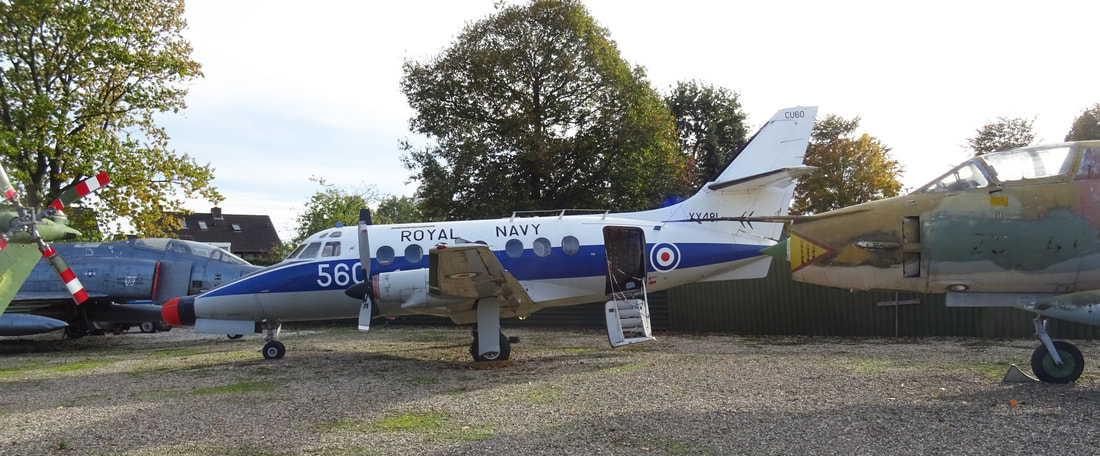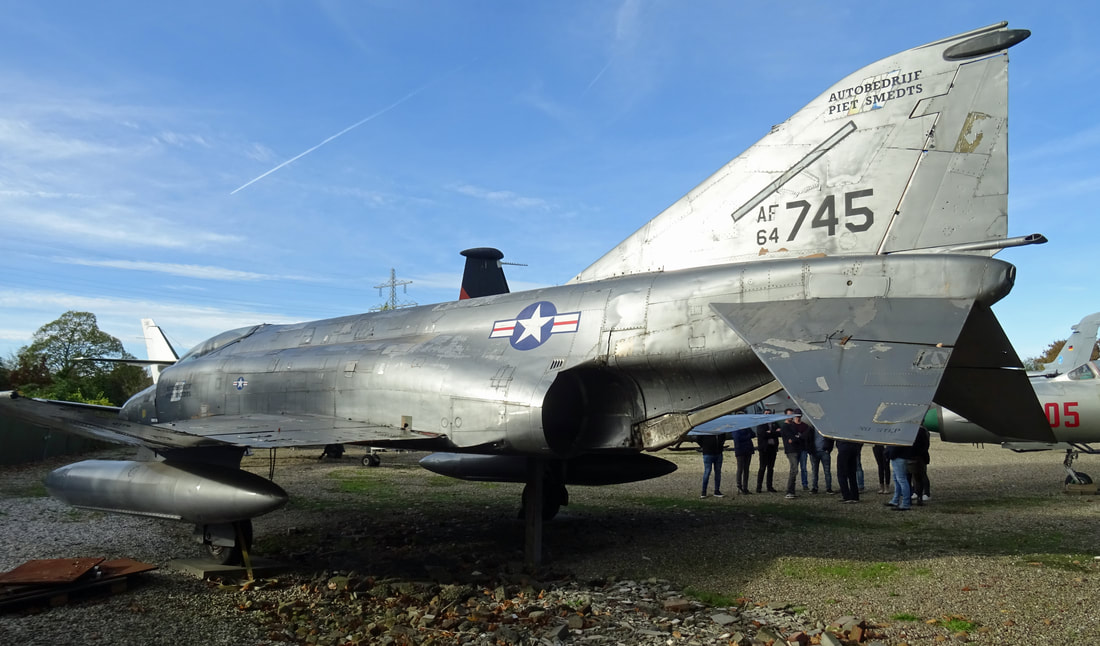PS. Aero in Baarlo, Limburg, re-visited in October 2019
by Jan Koppen
PS AERO is specialist supplieres of ex military aircraft, engines and spares. Planes, Helicopters ands spares for rental or sale.
The Lockheed F-104 Starfighter is a single-engine, supersonic interceptor aircraft which later became widely used as an attack aircraft. Initially a day fighter, it was developed into an all-weather fighter in the late 1960s. It was originally developed by Lockheed for the United States Air Force (USAF), but was later produced by several other nations, seeing widespread service outside the United States. One of the Century Series of fighter aircraft, it was operated by the air forces of more than a dozen nations from 1958 to 2004. Its design team was led by Kelly Johnson, who contributed to the development of the Lockheed P-38 Lightning, Lockheed U-2, Lockheed SR-71 Blackbird, and other Lockheed aircraft.
The F-104 set numerous world records, including both airspeed and altitude records. Its success was marred by the Lockheed bribery scandals, in which Lockheed had given bribes to a considerable number of political and military figures in various nations to influence their judgment and secure several purchase contracts; this caused considerable political controversy in Europe and Japan.
The poor safety record of the Starfighter also brought the aircraft into the public eye, especially in German Air Force (Luftwaffe) service. Fighter ace Erich Hartmann was put into early retirement from the Luftwaffe. Due to his outspoken opposition to the selection of the F-104.
The final production version of the fighter model was the F-104S, an all-weather interceptor designed by Aeritaliafor the Italian Air Force, and equipped with radar-guided AIM-7 Sparrow missiles. An advanced F-104 with a high-mounted wing, known as the CL-1200 Lancer, was considered, but did not proceed past the mock-up stage.
The F-104 set numerous world records, including both airspeed and altitude records. Its success was marred by the Lockheed bribery scandals, in which Lockheed had given bribes to a considerable number of political and military figures in various nations to influence their judgment and secure several purchase contracts; this caused considerable political controversy in Europe and Japan.
The poor safety record of the Starfighter also brought the aircraft into the public eye, especially in German Air Force (Luftwaffe) service. Fighter ace Erich Hartmann was put into early retirement from the Luftwaffe. Due to his outspoken opposition to the selection of the F-104.
The final production version of the fighter model was the F-104S, an all-weather interceptor designed by Aeritaliafor the Italian Air Force, and equipped with radar-guided AIM-7 Sparrow missiles. An advanced F-104 with a high-mounted wing, known as the CL-1200 Lancer, was considered, but did not proceed past the mock-up stage.
The F-104G was the main version produced as multi-role fighter-bombers. Manufactured by Lockheed, and under license by Canadair and a consortium of European companies that included Messerschmitt/MBB, Dornier, Fiat, Fokker, and SABCA. The type featured strengthened fuselage and wing structure, increased internal fuel capacity, an enlarged vertical fin, strengthened landing gear with larger tires, and revised flaps for improved combat maneuvering. Upgraded avionics included a new Autonetics NASARR F15A-41B radar with air-to-air and ground mapping modes, the Litton LN-3 Inertial Navigation System (the first on a production fighter), and an infrared sight.
The SEPECAT Jaguar is a British-French jet attack aircraft originally used by the British Royal Air Force and the French Air Force in the close air support and nuclear strike role. It is still in service in significantly upgraded form with the Indian Air Force.
Originally conceived in the 1960s as a jet trainer with a light ground attack capability, the requirement for the aircraft soon changed to include supersonic performance, reconnaissance and tactical nuclear strike roles. A carrier-based variant was also planned for French service, but this was cancelled in favour of the cheaper Dassault Super Étendard. The airframes were manufactured by SEPECAT (Société Européenne de Production de l'avion Ecole de Combat et d'Appui Tactique), a joint venture between Breguet and the British Aircraft Corporation, one of the first major joint-Anglo-French military aircraft programmes.
The Jaguar was exported to India, Oman, Ecuador and Nigeria. With various air forces, the Jaguar was used in numerous conflicts and military operations in Mauritania, Chad, Iraq, Bosnia, and Pakistan, as well as providing a ready nuclear delivery platform for Britain, France, and India throughout the latter half of the Cold War and beyond. In the Gulf War, the Jaguar was praised for its reliability and was a valuable coalition resource. The aircraft served with the French Air Force as the main strike/attack aircraft until 1 July 2005, and with the Royal Air Force until the end of April 2007. It was replaced by the Panavia Tornado and the Eurofighter Typhoon in the RAF and the Dassault Rafale in the French Air Force.
Originally conceived in the 1960s as a jet trainer with a light ground attack capability, the requirement for the aircraft soon changed to include supersonic performance, reconnaissance and tactical nuclear strike roles. A carrier-based variant was also planned for French service, but this was cancelled in favour of the cheaper Dassault Super Étendard. The airframes were manufactured by SEPECAT (Société Européenne de Production de l'avion Ecole de Combat et d'Appui Tactique), a joint venture between Breguet and the British Aircraft Corporation, one of the first major joint-Anglo-French military aircraft programmes.
The Jaguar was exported to India, Oman, Ecuador and Nigeria. With various air forces, the Jaguar was used in numerous conflicts and military operations in Mauritania, Chad, Iraq, Bosnia, and Pakistan, as well as providing a ready nuclear delivery platform for Britain, France, and India throughout the latter half of the Cold War and beyond. In the Gulf War, the Jaguar was praised for its reliability and was a valuable coalition resource. The aircraft served with the French Air Force as the main strike/attack aircraft until 1 July 2005, and with the Royal Air Force until the end of April 2007. It was replaced by the Panavia Tornado and the Eurofighter Typhoon in the RAF and the Dassault Rafale in the French Air Force.
Jaguar GR3A is a Jaguar with upgrade avionics to the GR1B/GR3.
The Fouga CM.170 Magister is a 1950s French two-seat jet trainer aircraft, developed and manufactured by French aircraft manufacturer Fouga. Due to industrial mergers, the aircraft has been variously known as the Fouga CM.170 Magister, Potez (Fouga) CM.170 Magister, Sud Aviation (Fouga) CM.170 Magister and Aérospatiale (Fouga) CM.170 Magister, depending on where and when they were built.
In 1948, development commenced at Fouga on a new primary trainer aircraft design that harnessed newly developed jet propulsion technology. The initial design was evaluated by the French Air Force (Armée de l'Air, AdA) and, in response to its determination that the aircraft lacked sufficient power for its requirements, was enlarged and adopted a pair of Turbomeca Marboré turbojet engines. First flying on 23 July 1952, the first production order for the type was received on 13 January 1954. Export orders for the Magister were received, which included arrangements to produce the type under license in West Germany, Finland and Israel. In addition, the related CM.175 Zéphyr was a carrier-capable version developed and produced for the French Navy.
While primarily operated as a trainer aircraft, the Magister was also frequently used in combat as a close air support platform by various operators. In the latter capacity, it saw action during the Six-Day War, the Salvadoran Civil War, the Western Sahara War, and the Congo Crisis. In French service, the Magister was eventually replaced by the Dassault/Dornier Alpha Jet. After its retirement by the French Air Force, Magisters were purchased by several private-owner pilots in the US and have since been operated in the experimental category.
In 1948, development commenced at Fouga on a new primary trainer aircraft design that harnessed newly developed jet propulsion technology. The initial design was evaluated by the French Air Force (Armée de l'Air, AdA) and, in response to its determination that the aircraft lacked sufficient power for its requirements, was enlarged and adopted a pair of Turbomeca Marboré turbojet engines. First flying on 23 July 1952, the first production order for the type was received on 13 January 1954. Export orders for the Magister were received, which included arrangements to produce the type under license in West Germany, Finland and Israel. In addition, the related CM.175 Zéphyr was a carrier-capable version developed and produced for the French Navy.
While primarily operated as a trainer aircraft, the Magister was also frequently used in combat as a close air support platform by various operators. In the latter capacity, it saw action during the Six-Day War, the Salvadoran Civil War, the Western Sahara War, and the Congo Crisis. In French service, the Magister was eventually replaced by the Dassault/Dornier Alpha Jet. After its retirement by the French Air Force, Magisters were purchased by several private-owner pilots in the US and have since been operated in the experimental category.
The Red Devils were the Belgium Air Force demonstration team., The team used the Potez-Air Fouga CM170R Magister twin engined jet trainer and was based at the Brustem Airbase. The two seat jet trainer Potez-Air Fouga CM170R Magister was purchased by the Belgian government in 1958. Between 1965 and 1977 Fouga Magisters of the Red Devils performed in several airshows in Europe and became well known ambassadors for the Belgian Air Force.
The Dutch Police used also the type for various duties. It was operated by the "Rijkspolitie" in the nineteen nineties.
16520 is a Lockheed T-33A Shooting Star of the French Air Force.
|
The Lockheed T-33 Shooting Star (or T-Bird) is a subsonic American jet trainer. It was produced by Lockheed and made its first flight in 1948. The T-33 was developed from the Lockheed P-80/F-80 starting as TP-80C/TF-80C in development, then designated T-33A. It was used by the U.S. Navy initially as TO-2, then TV-2, and after 1962, T-33B. The last operator of the T-33, the Bolivian Air Force, retired the type in July 2017, after 44 years of service.[1]
|
The Messerschmitt-Bölkow-Blohm Bo 105 is a light, twin-engine, multi-purpose helicopter developed by Bölkowof Ottobrunn, West Germany. It was the first light twin-engine helicopter in the world, and the first rotorcraft that could perform aerobatic maneuvers such as inverted loops. The Bo 105 features a revolutionary hingelessrotor system, at that time a pioneering innovation in helicopters when it was introduced into service in 1970. Production of the Bo 105 began at the then-recently merged Messerschmitt-Bölkow-Blohm (MBB).
The main production facilities for producing the Bo 105 were located in Germany and Canada; due to the level of export sales encountered, additional manufacturing lines were set up in Spain, Indonesia, and the Philippines. MBB became a part of Eurocopter in 1991, who continued production of the type until 2001. The Bo 105 was formally replaced in Eurocopter's product range by the newer Eurocopter EC135, which was itself a development of the Bo 105.
The main production facilities for producing the Bo 105 were located in Germany and Canada; due to the level of export sales encountered, additional manufacturing lines were set up in Spain, Indonesia, and the Philippines. MBB became a part of Eurocopter in 1991, who continued production of the type until 2001. The Bo 105 was formally replaced in Eurocopter's product range by the newer Eurocopter EC135, which was itself a development of the Bo 105.
|
The Bolkow-105CB4 is a light observation, utility transport version. Developed in 1976 and equipped with two Allison 250-C20B turbine engines of which 30 were delivered to The Royal Netherlands Air Force.
Three Bo-105 were auctioned by BVA auctions, for a asking price of Euro 25.000,- each in July 2019 |
The BAC Jet Provost is a British jet trainer aircraft that was in use with the Royal Air Force (RAF) from 1955 to 1993. It was originally developed by Hunting Percival from the earlier piston engine-powered Percival Provostbasic trainer, and later produced by the British Aircraft Corporation (BAC). In addition to the multiple RAF orders, the Jet Provost, sometimes with light armament, was exported to many air forces worldwide. The design was also further developed into a more heavily armed ground attack variant under the name BAC Strikemaster.
The T5.A is a modified T5 with improved avionics and a rough grey coating on the wing to break up the smooth airflow and
give the trainee pilot an early indication of the onset of a stall (the T5's original clean wing gave the pilot little warning).
give the trainee pilot an early indication of the onset of a stall (the T5's original clean wing gave the pilot little warning).
The Pratt & Whitney R-1830 Twin Wasp is an American aircraft engine widely used in the 1930s and 1940s. Produced by Pratt & Whitney, it is a two-row, 14-cylinder, air-cooled radial design with seven cylinders on a row. It displaces 1,830 cu in (30.0 L) and its bore and stroke are both 5.5 in (140 mm). A total of 173,618 R-1830 engines were built, and from their use in two of the most-produced aircraft ever built, the four-engined B-24 heavy bomber and twin-engined DC-3 transport, more Twin Wasps may have been built than any other aviation piston engine in history.
The Pratt & Whitney JT3D is an early turbofan aircraft engine derived from the Pratt & Whitney JT3C turbojet. It was first run in 1958 and was first flown in 1959 under a B-45 Tornado test aircraft. Over 8,000 JT3Ds were produced between 1959 and 1985. Most JT3D engines still in service today are used on military aircraft, where the engine is referred to by its USAF designation of TF33.
In April 1925, Frederick Rentschler, an Ohio native and former executive at Wright Aeronautical, was determined to start an aviation-related business of his own. His social network included Edward Deeds, another prominent Ohioan of the early aviation industry, and Frederick's brother Gordon Rentschler, both of whom were on the board of Niles Bement Pond, then one of the largest machine tool corporations in the world. Frederick Rentschler approached these men as he sought capital and assets for his new venture. Deeds and G. Rentschler persuaded the board of Niles Bement Pond that their Pratt & Whitney Machine Tool (P&WMT) subsidiary of Hartford, Connecticut, should provide the funding and location to build a new aircraft engine being developed by Rentschler, George J. Mead, and colleagues, all formerly of Wright Aeronautical. Conceived and designed by Mead, the new engine would be a large, air-cooled, radial design. Pratt & Whitney Machine Tool was going through a period of self-revision at the time to prepare itself for the post-Great War era, discontinuing old product lines and incubating new ones. The Great War had been profitable to P&WMT, but the peace brought a predictable glut to the machine tool market, as contracts with governments were canceled and the market in used, recently built tools competed against new ones. P&WMT's future growth would depend on innovation. Having idle factory space and capital available at this historical moment, to be invested wherever good return seemed available, P&WMT saw the postwar aviation industry, both military and civil (commercial, private), as one with some of the greatest growth and development potential available anywhere for the next few decades. It lent Rentschler $250,000, the use of the Pratt & Whitney name, and space in their building. This was the beginning of the Pratt & Whitney Aircraft Company.
The Alpha Jet A 40+58 was a trainer version which was used by the Germans Air Force
|
The Dassault/Dornier Alpha Jet is a light attack jet and advanced jet trainer co-manufactured by Dassault Aviation of France and Dornier Flugzeugwerke of Germany. It was developed specifically to perform the trainer and light attack missions, as well as to perform these duties more ideally than the first generation of jet trainers that preceded it. Following a competition, a design submitted by a team comprising Breguet Aviation, Dassault Aviation, and Dornier Flugzeugwerke, initially designated as the TA501, was selected and subsequently produced as the Alpha Jet.
Both the French Air Force and German Air Force procured the Alpha Jet in large numbers, the former principally as a trainer aircraft and the latter choosing to use it as a light attack platform. As a result of post-Cold War military cutbacks, Germany elected to retire its own fleet of Alpha Jets in the 1990s and has re-sold many of these aircraft to both military and civilian operators. The Alpha Jet has been adopted by a number of air forces across the world and has also seen active combat use by some of these operators. |
The Mikoyan-Gurevich MiG-23 ; NATO reporting name: Flogger, is a variable-geometry fighter aircraft, designed by the Mikoyan-Gurevich design bureau in the Soviet Union. It is a third-generation jet fighter, the world's most-produced variable-geometry aircraft, along with similar Soviet fighters such as the Su-15 "Flagon". It was the first Soviet fighter to field a look-down/shoot-down radar and one of the first to be armed with beyond visual range missiles. Production started in 1969 and reached large numbers with over 5,000 aircraft built. Today the MiG-23 remains in limited service with some export customers.
2422 is a former Czech Air Force MIG-23ML.
|
The early "Flogger" variants were intended to be used in high-speed missile attacks, but it was soon noticed that fighters often had to engage in more stressful close-in combat. Early production aircraft had actually suffered cracks in the fuselage during their service career. Maneuverability of the aircraft was also criticized. A considerable redesign of the airframe was performed, resulting in the MiG-23ML (L – lightweight), which made it in some ways a new aircraft. Empty weight was reduced by 1250 kg, which was achieved partly by removing a rear fuselage fuel tank. Aerodynamics were refined for less drag. The dorsal fin extension was removed. The lighter weight of the airframe resulted in a different sit on the ground, with the aircraft appearing more level when at rest compared to the nose-high appearance of earlier variants. This has led to a belief that the undercarriage was redesigned for the ML variant, but it is identical to earlier variants. The airframe was now rated for a g-limit of 8.5, compared to 8 g for the early generation MiG-23M/MF "Flogger-B". A new engine model, the R-35F-300, now provided a maximum dry thrust of 84 kN (18,800 lbf), and 127 kN (28,700 lb) with afterburner. This led to a considerable improvement in maneuverability and thrust-to-weight ratio. The avionics set was considerably improved as well. The S-23ML standard included Sapfir-23ML radar and TP-23ML IRST.[88] The new radar was more reliable and a had maximum detection range of about 65 km against a fighter-sized target (25 km in look-down mode). The navigation suite received a new, much improved autopilot. New radio and datalink systems were also installed. The prototype of this variant first flew in 1976 and production began 1978.
|
Mirage IIIRS is the export version of the Mirage IIIR for the Swiss Air Force. 18 jets were built.
|
The Dassault Mirage III is a family of single-seat, single-engine, fighter aircraft developed and manufactured by French aircraft company Dassault Aviation. During October 1960, the first major production model, designated as the Mirage IIIC, performed its maiden flight.
The Argentine Air Force utilised the Mirage IIIEA during the Falklands War, but their lack of an aerial refueling capability limited their usefulness in the conflict. Even using drop tanks, the Mirages only had an endurance of five minutes within the combat area around the British fleet. |
Still as good looking as ever. As a note, she is currently approx. 50 years old.
MiG-21UM is a two-seat training version of the MiG-21MF. (U = Uchebnyy "Training", M = Modernizovannyy "Modernised")
|
The Mikoyan-Gurevich MiG-21, NATO reporting name Fishbed, is a supersonic jet fighter and interceptor aircraft, designed by the Mikoyan-Gurevich Design Bureau in the Soviet Union. Its nicknames include: Balalaika, because its planform resembles the stringed musical instrument of the same name; Ołówek, Polish for "pencil", due to the shape of its fuselage and; Én bạc, meaning "Silver Swallow", in Vietnamese.
Approximately 60 countries over four continents have flown the MiG-21, and it still serves many nations six decades after its maiden flight. It made aviation records, became the most-produced supersonic jet aircraft in aviation history, the most-produced combat aircraft since the Korean War and previously the longest production run of a combat aircraft (now exceeded by both the McDonnell Douglas F-15 Eagle and General Dynamics F-16 Fighting Falcon). The MiG-21 jet fighter was a continuation of Soviet jet fighters, starting with the subsonic MiG-15 and MiG-17, and the supersonic MiG-19. A number of experimental Mach 2 Soviet designs were based on nose intakes with either swept-back wings, such as the Sukhoi Su-7, or tailed deltas, of which the MiG-21 would be the most successful. Development of what would become the MiG-21 began in the early 1950s, when Mikoyan OKB finished a preliminary design study for a prototype designated Ye-1 in 1954. This project was very quickly reworked when it was determined that the planned engine was underpowered; the redesign led to the second prototype, the Ye-2. Both these and other early prototypes featured swept wings. The first prototype with delta wings as found on production variants was the Ye-4. It made its maiden flight on 16 June 1955 and its first public appearance during the Soviet Aviation Day display at Moscow's Tushino airfield in July 1956. |
|
In the West, due to the lack of available information, early details of the MiG-21 often were confused with those of similar Soviet fighters of the era. In one instance, Jane's All the World's Aircraft 1960–1961 listed the "Fishbed" as a Sukhoi design and used an illustration of the Su-9 'Fishpot'.
A total of 10,645 aircraft were built in the USSR. They were produced in three factories: AZ 30 (3,203 aircraft) in Moscow (also known as MMZ Znamya Truda), GAZ 21 (5,765 aircraft) in Gorky and TAZ 31 (1,678 aircraft) in Tbilisi. Generally, Gorky built single-seaters for the Soviet forces. Moscow constructed single-seaters for export, and Tbilisi manufactured the twin-seaters both for export and the USSR, though there were exceptions. The MiG-21R and MiG-21bis for export and for the USSR were built in Gorky, 17 single-seaters were helmed in Tbilisi (MiG-21 and MiG-21F), the MiG-21MF was first constructed in Moscow and then Gorky, and the MiG-21U was built in Moscow as well as in Tbilisi. Due to the mass production, the aircraft was very cheap: the MiG-21MF, for example, was cheaper than the Russian BMP-1 tank. The F-4 Phantom's cost was several times higher than MiG-21. |
The Wasp HAS.1 #445 was a shipboard anti-submarine warfare helicopter for the Royal Navy.
The Westland Wasp was a small 1960s British turbine powered, shipboard anti-submarine helicopter. Produced by Westland Helicopters, it came from the same P.531 programme as the British Army Westland Scout, and was based on the earlier piston-engined Saunders-Roe Skeeter. It fulfilled the requirement of the Royal Navy for a helicopter small enough to land on the deck of a frigate and carry a useful load of two homing torpedoes.
The Wasp sank one ship in combat, seriously damaging the ARA Santa Fe submarine in 1982 during the Falklands war.
|
HMS Plymouth was built at No.1 Slip in South Yard at Devonport Dockyard, and was launched by Viscountess Astor on 20 July, 1959. She was named after the city of Plymouth and was only the second warship in the history of the Royal Navy to be so named.
She served as the leader of the 22nd Escort Squadron between 1963 and 1964, and leader of the 29th Escort Squadron from 1964 to 1966 in Singapore and Australia. Then, between 1966 to 1969 Plymouth underwent a major modernisation, with a a hangar and flight deck added to her aft to allow her to be the operations base for a Westfield Wasp helicopter. On April 28, alongside Antrim, Brilliant and Endurance, she helped to recapture South Georgia during Operation Paraquet. Royal Marines used her Westland Wasp helicopters to land on the island and attack Argentine troops. Her Wasp helicopter also took part in the attack on the Argentinian submarine Santa Fe. On June 8, 1982, HMS Plymouth was attacked by Argentine Air Force fighter-bombers - and hit with four 1000lb bombs and several cannon shells. While all of the bombs failed to explode, one detonated a depth charge and started a fire, one went straight through her funnel and two more destroyed her anti-submarine mortar. Then, at 2100 hours on June 14, 1982, the commander of the Argentine garrison in Stanley, General Mario Menéndez, officially surrendered to the British Major General Jeremy Moore, in her wardroom. |
After the war, HMS Plymouth returned to Rosyth Dockyard for a full repair and a refit, but she was decommissioned a few short years later, in 1988. She still remained afloat though, being run as as a floating museum - until the collapse of the Warship Preservation Trust in 2006, when she was taken to the Vittoria Dock in Birkenhead.
|
The Alpha Jet A was the attack version which was originally used by the Germans.
|
The Dassault/Dornier Alpha Jet is a light attack jet and advanced jet trainer co-manufactured by Dassault Aviation of France and Dornier Flugzeugwerke of Germany. It was developed specifically to perform the trainer and light attack missions, as well as to perform these duties more ideally than the first generation of jet trainers that preceded it. Following a competition, a design submitted by a team comprising Breguet Aviation, Dassault Aviation, and Dornier Flugzeugwerke, initially designated as the TA501, was selected and subsequently produced as the Alpha Jet.
Both the French Air Force and German Air Force procured the Alpha Jet in large numbers, the former principally as a trainer aircraft and the latter choosing to use it as a light attack platform. As a result of post-Cold War military cutbacks, Germany elected to retire its own fleet of Alpha Jets in the 1990s and has re-sold many of these aircraft to both military and civilian operators. The Alpha Jet has been adopted by a number of air forces across the world and has also seen active combat use by some of these operators. |
Alpha Jet 40+65 was the attack version "A" which was originally used by the Germans.
|
The Dassault/Dornier Alpha Jet is a light attack jet and advanced jet trainer co-manufactured by Dassault Aviation of France and Dornier Flugzeugwerke of Germany. It was developed specifically to perform the trainer and light attack missions, as well as to perform these duties more ideally than the first generation of jet trainers that preceded it. Following a competition, a design submitted by a team comprising Breguet Aviation, Dassault Aviation, and Dornier Flugzeugwerke, initially designated as the TA501, was selected and subsequently produced as the Alpha Jet.
Both the French Air Force and German Air Force procured the Alpha Jet in large numbers, the former principally as a trainer aircraft and the latter choosing to use it as a light attack platform. As a result of post-Cold War military cutbacks, Germany elected to retire its own fleet of Alpha Jets in the 1990s and has re-sold many of these aircraft to both military and civilian operators. The Alpha Jet has been adopted by a number of air forces across the world and has also seen active combat use by some of these operators. |
The Westland Lynx is a British multi-purpose twin-engined military helicopter designed and built by Westland Helicopters at its factory in Yeovil. Originally intended as a utility craft for both civil and naval usage, military interest led to the development of both battlefield and naval variants. The Lynx went into operational usage in 1977 and was later adopted by the armed forces of over a dozen nations, primarily serving in the battlefield utility, anti-armour, search and rescue and anti-submarine warfare roles.
German Kriegsmarine F-104G Starfighter 26+44 sitting pretty at PS Aero, Baarlo, Limburg, Netherlands.
The Dassault Mercure is a twin-engined narrow-body jet-powered airliner developed and manufactured by French aircraft firm Dassault Aviation. According to Dassault, it was the first large-scale European cooperative civil aeronautics programme. The Mercure 100 was the first commercial airliner operated by an entirely female crew.
During 1967, the Mercure was proposed as a French counterpart to the American Boeing 737. It was Dassault's first venture into the commercial jet airliner market, the company having traditionally built fighters and executive jets. On 28 May 1971, the prototype conducted its maiden flight, while the type entered service on 4 June 1974 with French airline Air Inter.
Dassault Mercure-100 F-BTTJ served Air Inter faithfully for all of its life. During 1989 she was withdrawn from use and preserved in the Orly Musee Delta Athis Paray Aviation in full Air Inter colors. On June 15, 2013 she was transported in pieces to Baarlo, the Netherlands, for preservation.
|
Attempts were made to market the type in the US, including partnerships with Douglas, Lockheed and General Dynamics, with the vision of producing it in the United States. However, the Mercure had very little success on the market, which has been attributed to several factors, including a lack of range in comparison to rival aircraft. As a consequence, there were only 12 aircraft constructed, all of which having been built between 1971 and 1975. The Mercure performed its final flight in 1995.
|
Dassault Mercure-100 F-BTTJ served Air Inter faithfully for all of its life. During 1989 she was withdrawn from use and preserved in the Orly Musee Delta Athis Paray Aviation in full Air Inter colors. On June 15, 2013 she was transported in pieces to Baarlo, the Netherlands, for preservation.
|
Some machines are put into long-term storage, others are broken-up, parted-out and/or tore down like this former LAM - Linhas Aéreas de Moçambique Dash-8-400. She was transported from Maasticht-Aachen airport to Baarlo some time ago. Last registration was 2-CAUY.
|
The Sud Aviation SE 210 Caravelle is a French short/medium-range jet airliner. It holds the distinction of being the world's first jet-powered airliner to be developed for the short/medium-range market.
Development of the Caravelle by the French aircraft manufacturer SNCASE, a company that was keen to produce a passenger aircraft that utilized newly developed jet propulsion technology, began in the early 1950s. In order to achieve this, SNCASE formed partnerships with British companies such as de Havilland (which provided designs and components that it had developed for its own jet-powered airliner, the de Havilland Comet) and Rolls-Royce Limited (the supplier of the Caravelle's Rolls-Royce Avon turbojet engines). While much of the airliner's development, including its maiden flight on 27 May 1955, was conducted by SNCASE. By the time that the Caravelle entered revenue service on 26 April 1959, the firm had been merged into the larger Sud Aviation conglomerate.
Within a few years of commencing passenger services, the Caravelle became one of the most successful European first-generation jetliners. The airliner achieved substantial sales to operators throughout Europe and even managed to penetrate the U.S. market with United Airlines placing an order for 20 Caravelles. The Caravelle established the aft-mounted engine, clean-wing design configuration that is still used widely by smaller jetliners.
Development of the Caravelle by the French aircraft manufacturer SNCASE, a company that was keen to produce a passenger aircraft that utilized newly developed jet propulsion technology, began in the early 1950s. In order to achieve this, SNCASE formed partnerships with British companies such as de Havilland (which provided designs and components that it had developed for its own jet-powered airliner, the de Havilland Comet) and Rolls-Royce Limited (the supplier of the Caravelle's Rolls-Royce Avon turbojet engines). While much of the airliner's development, including its maiden flight on 27 May 1955, was conducted by SNCASE. By the time that the Caravelle entered revenue service on 26 April 1959, the firm had been merged into the larger Sud Aviation conglomerate.
Within a few years of commencing passenger services, the Caravelle became one of the most successful European first-generation jetliners. The airliner achieved substantial sales to operators throughout Europe and even managed to penetrate the U.S. market with United Airlines placing an order for 20 Caravelles. The Caravelle established the aft-mounted engine, clean-wing design configuration that is still used widely by smaller jetliners.
F-BHRA is an extreme unique aircraft. With construction number 01, she was Caravelle's first production aircraft. I feel, she should
be displayed in the prestigious Le Bouget Aviation Museum, instead of being part of the PS Aero collection in Baarlo, Limburg.
be displayed in the prestigious Le Bouget Aviation Museum, instead of being part of the PS Aero collection in Baarlo, Limburg.
The unusual cockpit window arrangement of the Caravelle. The entire cockpit design was licensed directly from the de Havilland Comet.
This elegant Sud-Avion 210 Caravelle III has spent its entire life with Air France flying
passenger's services between Europe and its Paris Charles de Gaulle base.
passenger's services between Europe and its Paris Charles de Gaulle base.
|
F-BHRA rolled—off the Toulouse production—line in April 1959. With construction number 01, she was delivered to Air France. Sixteen years later she was withdrawn from used and became a ground instruction object at Vilgenis. Until 2005 she remained in perfect condition at Vilgenis . Her stay at Vilgenis ended and she had to be removed from her hangar. Transfer costs to the museum of Paris Le Bourget or the museum in Toulouse were too high for their owners. Some years the Caravelle became part of a deal with Piet Smit of PS Aero in Baarlo, who moved the Caravelle to Limburg on July 29, 2011.
|
The sun has faded the colors of the ‘Hippocampus' logo. Ultra violet light is the culprit, bleaching out colors. Airplanes are no different and high altitude flight, such as that performed by the Big—Jets, accelerates the fading process.
The Caravelle was typically powered by a pair of British-built Rolls-Royce Avon turbojet engines, installed in a rear-mounted position close to the tail unit. Various different models of the Avon engine were adopted upon many versions of the airliner, often featuring increased thrust output and additional functionality such as thrust reversers. Alternative powerplants were adopted or proposed for use upon some Caravelle models, such as the U.S.-built Pratt & Whitney JT8D-1 and General Electric CJ-805-23C engines.
So love this iconic majesty
XN789 is a Lightning F.2A. It is a single-seat fighter (F.2s upgraded to near F.6 standard); featuring Avon 211R engines, retained ADEN cannon and Firestreak (replaceable Firestreak pack swappable with ADEN Cannon Pack for a total of four ADEN Cannon), arrestor hook and enlarged Ventral Tank for two hours flight endurance. A total of 31 converted from F.2.
|
English Electric Lightning is a fighter aircraft that served as an interceptor during the 1960s, the 1970s and into the late 1980s. It remains the only UK-designed-and-built fighter capable of Mach 2. The Lightning was designed, developed, and manufactured by English Electric, which was later absorbed by the newly-formed British Aircraft Corporation. Later the type was marketed as the BAC Lightning. It was operated by the Royal Air Force (RAF), the Kuwait Air Force (KAF) and the Royal Saudi Air Force (RSAF).
A unique feature of the Lightning's design is the vertical, staggered configuration of its two Rolls-Royce Avon turbojet engines within the fuselage. The Lightning was initially designed and developed as an interceptor to defend the V bomber airfields from attack by anticipated future nuclear-armed supersonic Soviet bombers such as what emerged as the Tupolev Tu-22, but it was subsequently also required to intercept other bomber aircraft such as the Tupolev Tu-16 and the Tupolev Tu-95. |
The Lightning has exceptional rate of climb, ceiling, and speed; pilots have described flying it as "being saddled to a skyrocket". This performance and the initially limited fuel supply made the Lightning a "fuel-critical" aircraft, meaning that its missions are dictated to a high degree by its limited range.
|
This Starfighter is hanging on by its teeth, hopefully it will stay 'lucky' for some more time!
|
Mil Mi-2S Hoplite showing her East German (301) and German (94+50) identities.
|
The Mil Mi-2 (NATO reporting name Hoplite) is a small, lightly armed turbine-powered transport helicopter that could also provide close air support when armed with 57 mm rockets and a 23 mm cannon.
|
This aircraft was the third prototype and the first Tornado with dual controls first flown August 5th 1975.
The Panavia Tornado is a family of twin-engine, variable-sweep wing multirole combat aircraft, jointly developed and manufactured by Italy, the United Kingdom, and West Germany. There are three primary Tornado variants: the Tornado IDS (interdictor/strike) fighter-bomber, the suppression of enemy air defences Tornado ECR (electronic combat/reconnaissance) and the Tornado ADV (air defence variant) interceptor aircraft.
The Tornado was developed and built by Panavia Aircraft GmbH, a tri-national consortium consisting of British Aerospace (previously British Aircraft Corporation), MBB of West Germany, and Aeritalia of Italy. It first flew on 14 August 1974 and was introduced into service in 1979–1980. Due to its multirole design, it was able to replace several different fleets of aircraft in the adopting air forces. The Royal Saudi Air Force (RSAF) became the only export operator of the Tornado in addition to the three original partner nations. A tri-nation training and evaluation unit operating from RAF Cottesmore, the Tri-National Tornado Training Establishment, maintained a level of international co-operation beyond the production stage.
The Tornado was operated by the Royal Air Force (RAF), Italian Air Force, and RSAF during the Gulf War of 1991, in which the Tornado conducted many low-altitude penetrating strike missions. The Tornados of various services were also used in conflicts in the former Yugoslavia during the Bosnian War and Kosovo War, the Iraq War, Libya during the Libyan civil war, as well as smaller roles in Afghanistan, Yemen, and Syria. Including all variants, 992 aircraft were built.
The Tornado was developed and built by Panavia Aircraft GmbH, a tri-national consortium consisting of British Aerospace (previously British Aircraft Corporation), MBB of West Germany, and Aeritalia of Italy. It first flew on 14 August 1974 and was introduced into service in 1979–1980. Due to its multirole design, it was able to replace several different fleets of aircraft in the adopting air forces. The Royal Saudi Air Force (RSAF) became the only export operator of the Tornado in addition to the three original partner nations. A tri-nation training and evaluation unit operating from RAF Cottesmore, the Tri-National Tornado Training Establishment, maintained a level of international co-operation beyond the production stage.
The Tornado was operated by the Royal Air Force (RAF), Italian Air Force, and RSAF during the Gulf War of 1991, in which the Tornado conducted many low-altitude penetrating strike missions. The Tornados of various services were also used in conflicts in the former Yugoslavia during the Bosnian War and Kosovo War, the Iraq War, Libya during the Libyan civil war, as well as smaller roles in Afghanistan, Yemen, and Syria. Including all variants, 992 aircraft were built.
Serial 98+08 is fake! She actually was a RAF Tornado GR1 with serial XX947 and built in 1975. This was the third prototype of the Tornado
and was for some time preserved and on display as the gate Guardian to the Transair Pilot Shop at Shoreham airport, close to Brighton.
and was for some time preserved and on display as the gate Guardian to the Transair Pilot Shop at Shoreham airport, close to Brighton.
RAF IDS (interdictor/strike) variants were initially designated the Tornado GR1 with later modified aircraft designated Tornado GR1A, Tornado GR1B, Tornado GR4 and Tornado GR4A. The first of 228 GR1s was delivered on 5 June 1979, and the type entered service in the early 1980s. A total of 142 aircraft were upgraded to GR4 standard from 1997 to 2003.
Aircraft Sales & Services (Pvt.) Limited (ASSL) is the very experienced charter company in Pakistan since 1976 with over 45,000 hours of flying time for their clients. ASSL has a state of the art office and facilities at its headquarters at the General Aviation Area, Jinnah International Airport where it has its own Hangar, Spare Parts Stores, Training Center, Operations Room, Battery Shops, Avionics Workshop and General Aviation Maintenance Shop.
Fokker F-27-500 AP-BHZ looks to be in superb condition.
|
AP-BHZ is a Fokker Friendship F-27-500 which has spent the first 5 years of its working life based in USA. Delivered in February 1986 to Air Wisconsin as N510AW, this Friendship was sold to Alpenair from Austria in May 1991 as OE-IPN. Life was short with Alpenair and one year later she became part of the Amadeus Air fleet. During May 1995 she was re-rgistrated D-ADUP and started working for Rationflug in Germany. During the 90’s she changed hands several time and Sky Team and BAC Express Airlines did operate the Friendship respectively. During 2003 she was hangered at Bade-Baden for possible sale and overhaul. Via several aircraft brokers such as; Myairlease and Aventure Aviation she ended up in Pakistan with JS Focus Air and later on with ASSL Aircraft Sales and Services. On January 14, 2013 she returned to her birth-ground and landed at Lelystad airport for a possible sale to the Fokker Friendship Association.
Since the foundation in 2016, FFA took the initiative to exploit a flying Fokker Friendship from the Netherlands. Initially, the foundation hoped to buy a F27 that was already in Lelystad. This unit came in 2013 to the Netherlands to be sold. This machine, the AP-BHZ, came from Pakistan and was in a hangar on Lelystad. Contacts with sellers were such that there was a sales agreement with an accepted purchase price. But there had to be technically quite a bit of it happening. To get the aircraft flying again, an extensive D-check had to be performed and two new engines should be installed. The financial resources for this were still too skinny to actually purchase. " The agreement for purchase for this F-27 was € 360,000. Additional costs were estimated at approximately € 600,000. The sellers did not want to wait any longer and sold the machine to PS Aero in Baarlo. |
|
The Mikoyan-Gurevich MiG-21, NATO reporting name Fishbed, is a supersonic jet fighter and interceptor aircraft, designed by the Mikoyan-Gurevich Design Bureau in the Soviet Union. Its nicknames include: Balalaika, because its planform resembles the stringed musical instrument of the same name; Ołówek, Polish for "pencil", due to the shape of its fuselage and; Én bạc, meaning "Silver Swallow", in Vietnamese.
Approximately 60 countries over four continents have flown the MiG-21, and it still serves many nations six decades after its maiden flight. It made aviation records, became the most-produced supersonic jet aircraft in aviation history, the most-produced combat aircraft since the Korean War and previously the longest production run of a combat aircraft (now exceeded by both the McDonnell Douglas F-15 Eagle and General Dynamics F-16 Fighting Falcon).
Approximately 60 countries over four continents have flown the MiG-21, and it still serves many nations six decades after its maiden flight. It made aviation records, became the most-produced supersonic jet aircraft in aviation history, the most-produced combat aircraft since the Korean War and previously the longest production run of a combat aircraft (now exceeded by both the McDonnell Douglas F-15 Eagle and General Dynamics F-16 Fighting Falcon).
1809 is a former Polish Air Force MiG-21M. The MIG-21M was the export variant for Warsaw Pact countries.
Development of what would become the MiG-21 began in the early 1950s, when Mikoyan OKB finished a preliminary design study for a prototype designated Ye-1 in 1954. This project was very quickly reworked when it was determined that the planned engine was underpowered; the redesign led to the second prototype, the Ye-2. Both these and other early prototypes featured swept wings. The first prototype with delta wings as found on production variants was the Ye-4. It made its maiden flight on 16 June 1955 and its first public appearance during the Soviet Aviation Day display at Moscow's Tushino airfield in July 1956.
The empennage of the MiG-21 consists of a vertical stabilizer, a stabilator and a small fin on the bottom of the tail to improve yaw control. The vertical stabilizer has a sweep angle of 60° and an area of 5.32 m² (on earlier version 3.8 m²) and a rudder. The stabilator has a sweep angle of 57°, an area of 3.94 m² and a span of 2.6 m.
In the West, due to the lack of available information, early details of the MiG-21 often were confused with those of similar Soviet fighters of the era. In one instance, Jane's All the World's Aircraft 1960–1961 listed the "Fishbed" as a Sukhoi design and used an illustration of the Su-9 'Fishpot'.
A total of 10,645 aircraft were built in the USSR. They were produced in three factories: AZ 30[N 1] (3,203 aircraft) in Moscow (also known as MMZ Znamya Truda), GAZ 21 (5,765 aircraft) in Gorky [N 2] and TAZ 31 (1,678 aircraft) in Tbilisi. Generally, Gorky built single-seaters for the Soviet forces. Moscow constructed single-seaters for export, and Tbilisi manufactured the twin-seaters both for export and the USSR, though there were exceptions. The MiG-21R and MiG-21bis for export and for the USSR were built in Gorky, 17 single-seaters were helmed in Tbilisi (MiG-21 and MiG-21F), the MiG-21MF was first constructed in Moscow and then Gorky, and the MiG-21U was built in Moscow as well as in Tbilisi.
Due to the mass production, the aircraft was very cheap: the MiG-21MF, for example, was cheaper than the Russian BMP-1 tank. The F-4 Phantom's cost was several times higher than MiG-21.
A total of 10,645 aircraft were built in the USSR. They were produced in three factories: AZ 30[N 1] (3,203 aircraft) in Moscow (also known as MMZ Znamya Truda), GAZ 21 (5,765 aircraft) in Gorky [N 2] and TAZ 31 (1,678 aircraft) in Tbilisi. Generally, Gorky built single-seaters for the Soviet forces. Moscow constructed single-seaters for export, and Tbilisi manufactured the twin-seaters both for export and the USSR, though there were exceptions. The MiG-21R and MiG-21bis for export and for the USSR were built in Gorky, 17 single-seaters were helmed in Tbilisi (MiG-21 and MiG-21F), the MiG-21MF was first constructed in Moscow and then Gorky, and the MiG-21U was built in Moscow as well as in Tbilisi.
Due to the mass production, the aircraft was very cheap: the MiG-21MF, for example, was cheaper than the Russian BMP-1 tank. The F-4 Phantom's cost was several times higher than MiG-21.
The fuselage is semi-monocoque with an elliptical profile and a maximum width of 1.24 m (4 ft 1 in). The air flow to the engine is regulated by an inlet cone in the air intake. On early model MiG-21s, the cone has three positions. For speeds up to Mach 1.5 the cone is fully retracted to the maximum aft position. For speeds between Mach 1.5 and Mach 1.9 the cone moves to the middle position. For speeds higher than Mach 1.9 the cone moves to the maximum forward position. On the later model MiG-21PF, the intake cone moves to a position based on the actual speed. The cone position for a given speed is calculated by the UVD-2M system using air pressures from in front and behind the compressor of the engine.
On both sides of the nose there are gills to supply the engine with more air while on the ground and during takeoff. In the first variant of the MiG-21, the pitot tube is attached to the bottom of the nose. After the MiG-21P variant, this tube is attached to the top of the air intake. Later versions shifted the pitot tube attachment point 15 degrees to the right, as seen from the cockpit and had an emergency pitot head on the right side, just ahead of the canopy and below the pilot's eyeline.
On both sides of the nose there are gills to supply the engine with more air while on the ground and during takeoff. In the first variant of the MiG-21, the pitot tube is attached to the bottom of the nose. After the MiG-21P variant, this tube is attached to the top of the air intake. Later versions shifted the pitot tube attachment point 15 degrees to the right, as seen from the cockpit and had an emergency pitot head on the right side, just ahead of the canopy and below the pilot's eyeline.
On the under side of the aircraft there are three air brakes, two at the front and one at the rear. The front air brakes have an area of 0.76 m², and a deflection angle of 35°. The rear air brake has an area of 0.46 m² and a deflection angle of 40°. The rear air brake is blocked if the airplane carries an external fuel tank. Behind the air brakes are the bays for the main landing gear. On the under side of the airplane, just behind the trailing edge of the wing are attachment points for two JATO rockets. The front section of the fuselage ends at former #28. The rear section of the fuselage starts at former #28a and is removable for engine maintenance.
2008 is a former Polish Air Force MiG-21M. The MIG-21M was the export variant for Warsaw Pact countries.
8909 is a MiG-21MF. It was the export version of the MiG-21SM, with RP-22 radar and R13-300 turbojet. The choice of weapons loads was increased with the addition of the R-60 and later the R-60M IR-seeking AAM (M = Modernizirovannyy "Modernised", F = Forsirovannyy "Uprated engine").
An airplane stored outside will be subject to streaking down the paintwork from dust and dirt deposits unless washed regularly.
1909 is a MIG-21R. Initially designated Izdeliye 03 to confuse outsiders, the MiG-21R's official "type" designation was Izdeliye 94R. The first production unit was rolled out in early 1966 and production continued until 1971. For recce missions, the MiG-21R could carry a Type D daylight PHOTINT pod, a Type N nighttime PHOTINT pod, a Type R general-purpose ELINT pod or a Type T pod housing a TV system, making the MiG-21R one of the first Soviet recce aircraft to make use of ELINT equipment. Small changes were made throughout the production run. Early-production units had the R11F2S-300 turbojet, which was replaced in later machines by the R13-300 powerplant. In the air-to-air role, the MiG-21R could carry two RS-2US or R-3S AAMs, and in the strike role it could be loaded with two UB-16-57UM or UB-32 rocket pods, two S-24 heavy unguided rockets or two bombs of up to 500kg weight (each).
The MiG-21 uses a tricycle type undercarriage. On most variants the main landing gear uses tires that are 800 mm in diameter and 200 mm in width. Only the MiG-21F variants use tires with the size 660×200 mm. The wheels of the main landing gear retract into the fuselage after rotating 87° and the shock absorbers retract into the wing. The nose gear retracts forward into the fuselage under the radar. The nose wheel can be lowered manually by simply unlocking its hatch from inside the cockpit. Thus, landing with undercarriage locked in the up position due to an internal failure was not a major issue, with a number of such successful landings on the nosewheel and ventral fuel tank or the airbrake.
The cabin is pressurized and air conditioned. On variants prior to the MiG-21PFM, the cabin canopy is hinged at the front. When ejecting, the SK-1 ejection seat connects with the canopy to make a capsule that encloses the pilot. The capsule protects the pilot from the high-speed airflow encountered during high-speed ejections. After ejection, the capsule opens to allow the pilot to parachute to the ground. However, ejecting at low altitudes can cause the canopy to take too long to separate, sometimes resulting in pilot death. The minimum height for ejection in level flight was 110 m. Starting from the MiG-21PFM, the canopy is hinged on the right side of the cockpit.
This MIG-23MF with fake serial 593 is former Nationalen Volksarmee (NVA) fighter 20+09.
Early Western reports claimed that the aircraft had poor dogfighting capability, due to being designed to outaccelerate the F-111. Later analysis showed the MiG-23 to be equivalent to the F-4, surpassed only by newer fourth-generation fighters, such as the F-14, F-15 and F-16 (the MiG-23 is considered a third-generation jet fighter). The Soviet combat manual for MiG-23M pilots claims the MiG-23M to have a slight superiority over the F-4 and Kfir, and describes combat history involving Syrian MiG-23MFs versus Israeli F-15 and F-16s, which it labels "successful". This manual also recommends tactics to be used against these fighters.
The Breguet Br.1150 Atlantic is a long-range maritime patrol aircraft designed and manufactured by Breguet Aviation. Introduced to service in 1965, it has been operated by several NATO countries, commonly performing maritime roles such as reconnaissance and anti-submarine warfare. The Atlantic is also capable of carrying air-to-ground munitions to perform ground-attack missions; a small number of aircraft were also equipped to perform ELINT operations. An updated version, the Atlantique 2 or ATL2, was produced by Dassault Aviation for the French Navy in the 1980s. Other operators of the Atlantic have included the German Navy, the Italian Air Force, the Pakistan Navy, and the Royal Netherlands Navy.
Marine Flieger Geschwader-3, Nordholz / Special scheme to 50 year celebration of the German navy.
|
The German Marineflieger operated a fleet of Atlantics between 1963 and 2005. A number of these aircraft were modified for SIGINT work and were based at Nordholz Naval Airbase. During the Cold War, they commonly flew across the Baltic Sea and along the border with East Germany; these flights often had American and British intelligence personnel on board in addition to their German crews. During the 1990s, Germany deployed SIGINT Atlantics to observe the United Nations embargo of Yugoslavia and for reconnaissance flights during the Kosovo War in 1999.
|
Instruments inside of 61+11, which is a former German Navy Breguet 1150 Atlantic.
Cockpits like these bring back memories from our more glorious aviation past back in the 70s and 80s, from times when we were
young, pure and innocent and flying onboard these submarine like shaped rockets was no less an adventure than today.
young, pure and innocent and flying onboard these submarine like shaped rockets was no less an adventure than today.
Her switches and controls, worn smooth by the touch of a thousand hands.
Breguet control panel.
A long time ago, Atlantics also flew, in the uniform of the Dutch 'Marine Luchtvaartdienst', form their Valkenburg NAS.
Lovely to look back and recall them.
Lovely to look back and recall them.
This KLu helicopter has a three colour camo scheme. At Baarlo are the B-40 and B-68.
Bo-105’s of the Royal Netherlands air force were used in the nineteen seventies and eighties. The Dutch Air Force (Royal Netherlands AF) groep "lichte vliegtuigen" was the unit that used the type, primarily on behalf of the Dutch Army.
The Lynx AH.7 is a further upgraded version for the Army Air Corps, with Gem 41-1 engines and uprated gearbox of AH.5 and new, larger, composite tail rotor. Later refitted with BERP type rotor blades. Twelve new build, with 107 Lynx AH.1s converted.[122] A small number also used by the Fleet Air Arm in support of the Royal Marines. The Lynx AH.7 can also be outfitted for the anti-armour role, with the attachment of 2 pylons, each carrying four BGM-71 TOW anti-tank guided missiles. In the light-lift role, it can carry an aircrew member armed with a cabin door mounted L7 General Purpose Machine Gun (GPMG), as well as troops for fast-rope or abseiling insertions, or regular landings. It can also transport cargo. Now replaced in the attack role by the Agusta Westland Apache attack helicopter.
Russian metal is often very charismatic!
Photographed a NVA MiG-23UB ("Flogger-C"). The 'UB' is very similar to MiG-23U except that the Tumansky R-29 turbojet engine replaced the older R-27 installed in the MiG-23U. Production continued until 1985 (for the export variant). A total of 769 examples were built, including conversions from the MiG-23U.
|
The East German Air Force was unique among Warsaw Pact countries in that it was often equipped with the most advanced Soviet fighters, instead of downgraded export models. As an extension of the Soviet 16th Air Army deployed in East Germany, the Luftstreitkräfte was expected to play a front-line role in any war with NATO. As a result, it was under closer Soviet control than the air forces of other Warsaw Pact states. After German reunification in 1990, the Luftwaffe assumed control over Luftstreitkräfte equipment and enlisted some of its personnel. Many of the GDR's military aircraft were obsolete or incompatible with NATO technical standards, and were sold to other countries.
|
East Germany's Nationalen Volksarmee saw the introduction of the MiG-23 in 1970.
XX974/FE was a Jaguar GR3A of the RAF 41 Sqn.
The RAF upgraded its Jaguar fleet to a common standard, incorporating TIALD and the ability to use new reconnaissance pods. The interim GR3 (Jaguar 96) upgrade added a new HUD, a new hand controller and stick top, integrated GPS and TERPROM Terrain Referenced Navigation. The further upgraded Jaguar GR3A introduced the new EO GP1 (JRP) digital reconnaissance pod, a helmet-mounted sight, improved cockpit displays, a datalink, and improved night vision goggles compatibility.
While the United States was cranking out Century Series fighters, all spectacular but none particularly effective in the role for which they were intended, the Soviet Union quietly came up with a weapon of enormous capability, performance, economy and longevity: the single-engine, Mach 2 Mikoyan-Gurevich MiG-21 “Fishbed.” It was an airplane that hewed to the classic “perfect is the enemy of good enough” approach. The Americans were trying to create superfighters in small numbers, but the Soviets wanted to fill the sky with thousands of simple, lightweight, reliable jets. After all, that strategy had worked splendidly with the AK-47 rifle.
|
The MiG-21 has been called the AK-47 of airplanes. “Rock-solid airframe,” noted a former aviation technician who ground-crewed on one. “Really the thing only needs to be topped off with fluids and it just goes and goes.” When the U.S. Air Force operated MiG-21s as adversary aircraft combat trainers, they found them to be, in the words of one crew chief, “Just like your family car. As long as it’s full of fuel, you pull it out of the garage and start it up.” Maintenance typically consisted of changing the oil, brakes and tires after every 50 sorties. “With a set of Home Depot metric socket wrenches and screwdrivers, you could get a lot of maintenance done on the little jet,” said another crew chief.
Even more important is the fact that a MiG-21bis can be had for $500,000. A secondhand F-16C can cost a small country $15 million. |
This MIG-21 is the former NVA 24+25.
Fishbed was its randomly chosen NATO identifier. The Soviets hated it, just as they hated Fagot, Faithless, Frogfoot and other Western names for their fighters. The MiG-21 had no official Russian identifier, but its popular handle was Balalaika, after the triangular folk instrument—an obvious reference to the MiG’s delta wing.
The MiG-21 had a long production run—1959 to 1985—and the airplane was thereafter updated and modified by companies in India, Israel and Romania; copied by the Chinese; and simply rebuilt and kept in service so long that even today there are 14 developing countries operating the ancient jet as their first-line fighter. The Fishbed is the most-produced supersonic fighter of all time, with 11,496 manufactured. Its baby brother, the transonic MiG-15, holds the all-time jet record: some 18,000 units.
Ex GAF 25+41 Sukoi SU-22-M-4K is actually the former NVA 743.
The Sukhoi Su-17 (NATO reporting name: Fitter) is a Sovietvariable-sweep wing fighter-bomber developed from the Sukhoi Su-7. It enjoyed a long career in Soviet, later Russian, service and was widely exported to Eastern Bloc, Arab air forces, Angola and Peru as the Su-20 and Su-22. It is the first variable-sweep wing of Russian/Soviet origin.
Royal Navy British Aerospace Jetstream T.2 XX 481 preserved at Baarlo, Limburg, Netherlands.
|
The Handley Page HP-137 Jetstream is a small twin turboprop airliner, with a pressurised fuselage. The aircraft was designed to meet the requirements of the United States commuter- and regional airline market. The design was later improved and built by British Aerospace as the Jetstream 31 and Jetstream 32 featuring different turboprop engines.
|
The Jetstream T.2 was a conversion of T1s for the Royal Navy as rear-crew trainers.
The McDonnell Douglas F-4 Phantom II is a tandem two-seat, twin-engine, all-weather, long-range supersonic jetinterceptor and fighter-bomber originally developed for the United States Navy by McDonnell Aircraft. It first entered service in 1960 with the Navy. Proving highly adaptable, it was also adopted by the United States Marine Corps and the United States Air Force, and by the mid-1960s had become a major part of their air arms.
The Phantom is a large fighter with a top speed of over Mach 2.2. It can carry more than 18,000 pounds (8,400 kg) of weapons on nine external hardpoints, including air-to-air missiles, air-to-ground missiles, and various bombs. The F-4, like other interceptors of its time, was initially designed without an internal cannon. Later models incorporated an M61 Vulcan rotary cannon. Beginning in 1959, it set 15 world records for in-flight performance, including an absolute speed record and an absolute altitude record.
The Phantom is a large fighter with a top speed of over Mach 2.2. It can carry more than 18,000 pounds (8,400 kg) of weapons on nine external hardpoints, including air-to-air missiles, air-to-ground missiles, and various bombs. The F-4, like other interceptors of its time, was initially designed without an internal cannon. Later models incorporated an M61 Vulcan rotary cannon. Beginning in 1959, it set 15 world records for in-flight performance, including an absolute speed record and an absolute altitude record.
|
The F-4 was used extensively during the Vietnam War. It served as the principal air superiority fighter for the U.S. Air Force, Navy, and Marine Corps and became important in the ground-attack and aerial reconnaissance roles late in the war. During the Vietnam War, one U.S. Air Force pilot, two weapon systems officers (WSOs), one U.S. Navy pilot and one radar intercept officer (RIO) became aces by achieving five aerial kills against enemy fighter aircraft. The F-4 continued to form a major part of U.S. military air power throughout the 1970s and 1980s, being gradually replaced by more modern aircraft such as the F-15 Eagle and F-16 Fighting Falcon in the U.S. Air Force, the F-14 Tomcat in the U.S. Navy, and the F/A-18 Hornet in the U.S. Navy and U.S. Marine Corps.
|
The F-4C was a variant build for the U.S. Air Force.
The F-4 Phantom II remained in use by the U.S. in the reconnaissance and Wild Weasel (Suppression of Enemy Air Defenses) roles in the 1991 Gulf War, finally leaving service in 1996. It was also the only aircraft used by both U.S. flight demonstration teams: the United States Air Force Thunderbirds (F-4E) and the United States Navy Blue Angels (F-4J). The F-4 was also operated by the armed forces of 11 other nations. Israeli Phantoms saw extensive combat in several Arab–Israeli conflicts, while Iran used its large fleet of Phantoms, acquired before the fall of the Shah, in the Iran–Iraq War. Phantom production ran from 1958 to 1981, with a total of 5,195 built, making it the most produced American supersonic military aircraft. As of 2018, 60 years after its first flight, the F-4 remains in service with Iran, Japan, South Korea, Greece, and Turkey. The aircraft has most recently been in service against the Islamic State group in the Middle East.
- The End -


